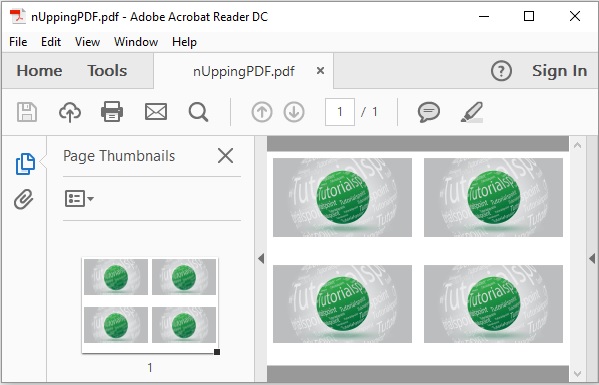
- iText Tutorial
- iText - Home
- iText Introduction
- iText - Overview
- iText - Creating a PDF Document
- iText - Adding an AreaBreak
- iText - Adding a Paragraph
- iText - Adding a List
- iText Tables
- iText - Adding a Table
- iText - Formatting Cell Contents
- Formatting the Borders of a Cell
- iText - Adding Image to a Table
- iText - Nested Table
- iText - Adding Lists to a Table
- iText Images
- iText - Adding Image to a PDF
- iText - Setting Position of the Image
- iText - Scaling an Image
- iText - Rotating an Image
- iText Annotations
- iText - Text Annotation
- iText - Link Annotation
- iText - Line Annotation
- iText - Markup Annotation
- iText - Circle Annotation
- iText Miscellaneous
- iText - Setting Font
- iText - Shrinking the Content
- iText - Tiling PDF Pages
- iText - N-up
- iText Useful Resources
- iText - Quick Guide
- iText - Useful Resources
- iText - Discussion
iText - Quick Guide
iText - Overview
The Portable Document Format (PDF) is a file format that helps to present data in a manner that is independent of application software, hardware, and operating systems. Each PDF file holds description of a fixed-layout flat document, including text, fonts, graphics, and other information needed to display it.
There are several libraries available to create and manipulate PDF documents through programs, such as −
Adobe PDF Library − This library provides API in languages such as C++, .NET and Java. Using this, we can edit, view, print, and extract text from PDF documents.
Formatting Objects Processor − Open-source print formatter driven by XSL Formatting Objects and an output independent formatter. The primary output target is PDF.
PDF Box − Apache PDFBox is an open-source Java library that supports the development and conversion of PDF documents. Using this library, you can develop Java programs that create, convert and manipulate PDF documents.
Jasper Reports − This is a Java reporting tool which generates reports in PDF document including Microsoft Excel, RTF, ODT, comma-separated values and XML files.
What is iText?
Similar to above listed software's iText is a Java PDF library using which, you can develop Java programs that create, convert, and manipulate PDF documents.
Features of iText
Following are the notable features of iText library −
Interactive − iText provides you classes (API's) to generate interactive PDF documents. Using these, you can create maps and books.
Adding bookmarks, page numbers, etc − Using iText, you can add bookmarks, page numbers, and watermarks.
Split & Merge − Using iText, you can split an existing PDF into multiple PDFs and also add/concatenate additional pages to it.
Fill Forms − Using iText, you can fill interactive forms in a PDF document.
Save as Image − Using iText, you can save PDFs as image files, such as PNG or JPEG.
Canvas − iText library provides you a Canvas class using which you can draw various geometrical shapes on a PDF document like circle, line, etc.
Create PDFs − Using iText, you can create a new PDF file from your Java programs. You can include images and fonts too.
IText Environment
Follow the steps given below to set the iText environment on Eclipse.
Step 1 − Install Eclipse and open a new project in it as shown below.
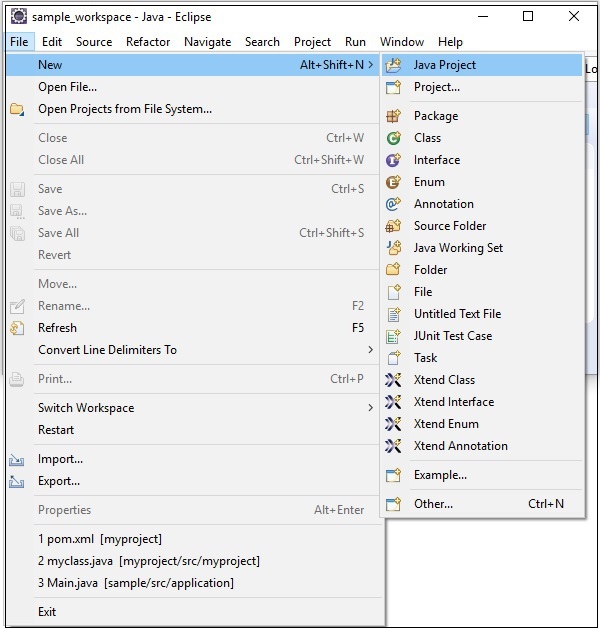
Step 2 − Create an iTextSample project as shown below.
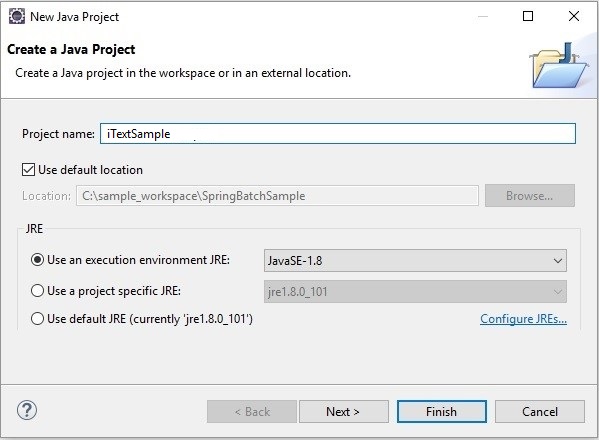
Step 3 − Right-click on the project and convert it into a Maven project as shown below. Once you convert it into Maven project, it will give you a pom.xml where you need to mention the required dependencies. Thereafter, the jar files of those dependencies will be automatically downloaded into your project.

Step 4 − Now, in the pom.xml of the project, copy and paste the following content (dependencies for iText application) and refresh the project.
Using pom.xml
Convert the project into Maven project and add the following content to its pom.xml.
<project xmlns="http://maven.apache.org/POM/4.0.0"
xmlns:xsi="http://www.w3.org/2001/XMLSchema-instance"
xsi:schemaLocation="http://maven.apache.org/POM/4.0.0
http://maven.apache.org/xsd/maven-4.0.0.xsd">
<modelVersion>4.0.0</modelVersion>
<groupId>SanthoshExample</groupId>
<artifactId>SanthoshExample</artifactId>
<version>0.0.1-SNAPSHOT</version>
<build>
<sourceDirectory>src</sourceDirectory>
<plugins>
<plugin>
<artifactId>maven-compiler-plugin</artifactId>
<version>3.5.1</version>
<configuration>
<source>1.8</source>
<target>1.8</target>
</configuration>
</plugin>
</plugins>
</build>
<dependencies>
<!-- always needed -->
<dependency>
<groupId>com.itextpdf</groupId>
<artifactId>kernel</artifactId>
<version>7.0.2</version>
</dependency>
<dependency>
<groupId>com.itextpdf</groupId>
<artifactId>io</artifactId>
<version>7.0.2</version>
</dependency>
<dependency>
<groupId>com.itextpdf</groupId>
<artifactId>layout</artifactId>
<version>7.0.2</version>
</dependency>
<dependency>
<groupId>com.itextpdf</groupId>
<artifactId>forms</artifactId>
<version>7.0.2</version>
</dependency>
<dependency>
<groupId>com.itextpdf</groupId>
<artifactId>pdfa</artifactId>
<version>7.0.2</version>
</dependency>
<dependency>
<groupId>com.itextpdf</groupId>
<artifactId>sign</artifactId>
<version>7.0.2</version>
</dependency>
<dependency>
<groupId>com.itextpdf</groupId>
<artifactId>barcodes</artifactId>
<version>7.0.2</version>
</dependency>
<dependency>
<groupId>com.itextpdf</groupId>
<artifactId>font-asian</artifactId>
<version>7.0.2</version>
</dependency>
<dependency>
<groupId>com.itextpdf</groupId>
<artifactId>hyph</artifactId>
<version>7.0.2</version>
</dependency>
</dependencies>
</project>
Finally, if you observe the Maven dependencies, you can observe that all the required jar files were downloaded.
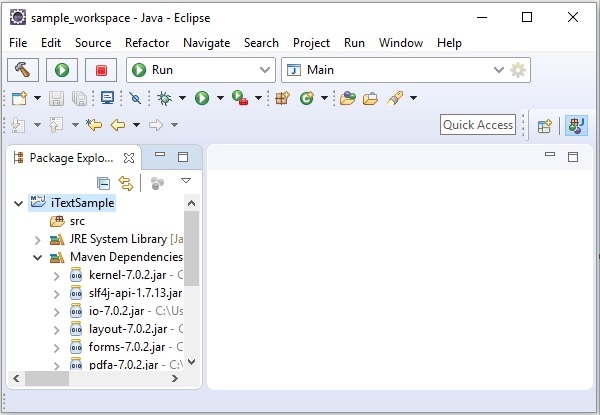
iText - Creating a PDF Document
Let us now understand how to create a PDF document using the iText library.
Creating an Empty PDF Document
You can create an empty PDF Document by instantiating the Document class. While instantiating this class, you need to pass a PdfDocument object as a parameter to its constructor.
Following are the steps to create an empty PDF document.
Step 1: Creating a PdfWriter object
The PdfWriter class represents the Doc Writer for a PDF. This class belongs to the package com.itextpdf.kernel.pdf. The constructor of this class accepts a string, representing the path of the file where the PDF is to be created.
Instantiate the PdfWriter class by passing a string value (representing the path where you need to create a PDF) to its constructor, as shown below.
// Creating a PdfWriter String dest = "C:/itextExamples/sample.pdf"; PdfWriter writer = new PdfWriter(dest);
When an object of this type is passed to a PdfDocument (class), every element added to this document will be written to the file specified.
Step 2: Creating a PdfDocument object
The PdfDocument class is the class that represents the PDF Document in iText. This class belongs to the package com.itextpdf.kernel.pdf. To instantiate this class (in writing mode), you need to pass an object of the class PdfWriter to its constructor.
Instantiate the PdfDocument class by passing the above created PdfWriter object to its constructor, as shown below.
// Creating a PdfDocument PdfDocument pdfDoc = new PdfDocument(writer);
Once a PdfDocument object is created, you can add various elements like page, font, file attachment, and event handler using the respective methods provided by its class.
Step 3: Adding an empty page
The addNewPage() method of the PdfDocument class is used to create an empty page in the PDF document.
Add an empty page to the PDF document created in the previous step as shown below.
// Adding an empty page pdfDoc.addNewPage();
Step 4: Creating a Document object
The Document class of the package com.itextpdf.layout is the root element while creating a self-sufficient PDF. One of the constructors of this class accepts an object of the class PdfDocument.
Instantiate the Document class by passing the object of the class PdfDocument created in the previous steps as shown below.
// Creating a Document Document document = new Document(pdfDoc);
Step 5: Closing the Document
Close the document using the close() method of the Document class as shown below.
// Closing the document document.close();
Example
Following is the Java program which demonstrates the creation of a PDF Document. It creates a PDF document with the name sample.pdf, adds an empty page to it, and saves it in the path C:/itextExamples/
Save this code in a file with the name create_PDF.java.
import com.itextpdf.kernel.pdf.PdfDocument;
import com.itextpdf.kernel.pdf.PdfWriter;
import com.itextpdf.layout.Document;
public class create_PDF {
public static void main(String args[]) throws Exception {
// Creating a PdfWriter
String dest = "C:/itextExamples/sample.pdf";
PdfWriter writer = new PdfWriter(dest);
// Creating a PdfDocument
PdfDocument pdfDoc = new PdfDocument(writer);
// Adding a new page
pdfDoc.addNewPage();
// Creating a Document
Document document = new Document(pdfDoc);
// Closing the document
document.close();
System.out.println("PDF Created");
}
}
Compile and execute the saved Java file from the Command prompt using the following commands −
javac create_PDF.java java create_PDF
Upon execution, the above program creates a PDF document, displaying the following message.
PDF created
If you verify the specified path, you can find the created PDF document as shown below.
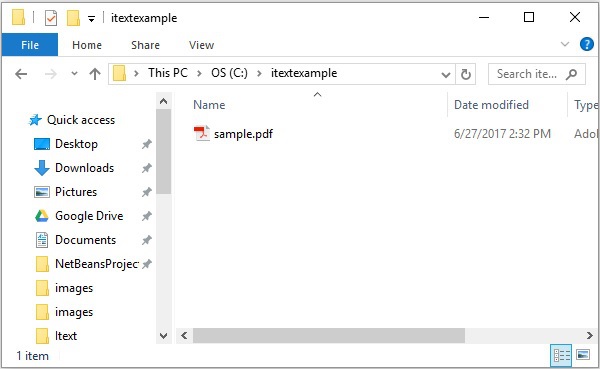
Since this is an empty document, if you try to open this document, it will display an error message, as shown in the following screenshot.

iText - Adding an AreaBreak
In this chapter, we will see how to create a PDF document with AreaBreak using the iText library.
Creating an AreaBreak
You can create an empty PDF Document by instantiating the Document class. While instantiating this class, you need to pass a PdfDocument object as a parameter, to its constructor. Then, to add an areabreak to the document, you need to instantiate the AreaBreak class and add this object to document using the add() method.
Following are the steps to create an empty PDF document with AreaBreak.
Step 1: Creating a PdfWriter object
The PdfWriter class represents the Doc Writer for a PDF, this class belongs to the package com.itextpdf.kernel.pdf. The constructor of this class accepts a string, representing the path of the file where the PDF is to be created.
Instantiate PdfWriter class by passing a string value representing the path where you need to create a PDF, to its constructor, as shown below.
// Creating a PdfWriter String dest = "C:/itextExamples/addingAreaBreak.pdf"; PdfWriter writer = new PdfWriter(dest);
When an object of this type is passed to a PdfDocument (class), then every element added to this document will be written to the file specified.
Step 2: Creating a PdfDocument object
The PdfDocument class is the class that represents the PDF Document in iText, this class belongs to the package com.itextpdf.kernel.pdf. To instantiate this class (in writing mode) you need to pass an object of the class PdfWriter to its constructor.
Instantiate the PdfDocument class by passing above created PdfWriter object to its constructor, as shown below.
// Creating a PdfDocument PdfDocument pdfDoc = new PdfDocument(writer);
Once a PdfDocument object is created you can add various elements like page, font, file attachment, event handler using the respective methods provided by its class.
Step 3: Creating a Document object
The Document class of the package com.itextpdf.layout is the root element while creating a self-sufficient PDF. One of the constructors of this class accepts an object of the class PdfDocument.
Instantiate the Document class by passing the object of the class PdfDocument created in the previous steps, as shown below.
// Creating a Document Document document = new Document(pdfDoc);
Step 4: Creating an Area Break object
The AreaBreak class belongs to the package com.itextpdf.layout.element. On instantiating this class, the current context area will be terminated and a new one will be created with the same size (in case we use default constructor).
Instantiate the AreaBreak class as shown below.
// Creating an Area Break AreaBreak aB = new AreaBreak();
Step 5: Adding AreaBreak
Add the areabreak object created in the previous step using the add() method of the Document class, as shown below.
// Adding area break to the PDF document.add(aB);
Step 6: Closing the Document
Close the document using the close() method of the Document class as shown below.
// Closing the document document.close();
Example
The following Java program demonstrates how to create a PDF document with AreaBreak using the iText library. It creates a PDF document with the name addingAreaBreak.pdf, adds an areabreak to it, and saves it in the path C:/itextExamples/.
Save this code in a file with the name AddingAreaBreak.java.
import com.itextpdf.kernel.pdf.PdfDocument;
import com.itextpdf.kernel.pdf.PdfWriter;
import com.itextpdf.layout.Document;
import com.itextpdf.layout.element.AreaBreak;
public class AddingAreaBreak {
public static void main(String args[]) throws Exception {
// Creating a PdfWriter
String dest = "C:/itextExamples/addingAreaBreak.pdf";
PdfWriter writer = new PdfWriter(dest);
// Creating a PdfDocument
PdfDocument pdf = new PdfDocument(writer);
// Creating a Document by passing PdfDocument object to its constructor
Document document = new Document(pdf);
// Creating an Area Break
AreaBreak aB = new AreaBreak();
// Adding area break to the PDF
document.add(aB);
// Closing the document
document.close();
System.out.println("Pdf created");
}
}
Compile and execute the saved Java file from the Command prompt using the following commands −
javac AddingAreaBreak.java java AddingAreaBreak
Upon execution, the above program creates a PDF document, displaying the following message.
Pdf Created
If you verify the specified path, you can find the created PDF document, as shown below.
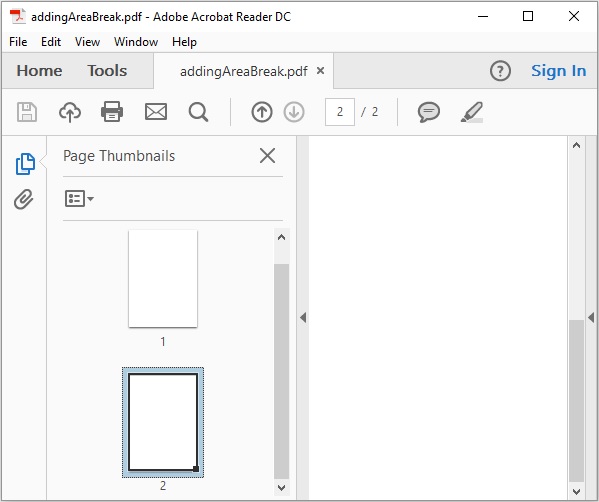
iText - Adding a Paragraph
In this chapter, we will see how to create a PDF document and add a paragraph to it using the iText library.
Creating a Paragraph
You can create an empty PDF Document by instantiating the Document class. While instantiating this class, you need to pass a PdfDocument object as a parameter, to its constructor. Then, to add a paragraph to the document, you need to instantiate the Paragraph class and add this object to the document using the add() method.
Following are the steps to create a PDF document with a paragraph in it.
Step 1: Creating a PdfWriter object
The PdfWriter class represents the Doc Writer for a PDF. This class belongs to the package com.itextpdf.kernel.pdf. The constructor of this class accepts a string, representing the path of the file where the PDF is to be created.
Instantiate the PdfWriter class by passing a string value (representing the path where you need to create a PDF) to its constructor, as shown below.
// Creating a PdfWriter String dest = "C:/itextExamples/addingParagraph.pdf"; PdfWriter writer = new PdfWriter(dest);
When the object of this type is passed to a PdfDocument (class), every element added to this document will be written to the file specified.
Step 2: Creating a PdfDocument
The PdfDocument class is the class that represents the PDF Document in iText. This class belongs to the package com.itextpdf.kernel.pdf. To instantiate this class (in writing mode), you need to pass an object of the class PdfWriter to its constructor.
Instantiate the PdfDocument class by passing the above created PdfWriter object to its constructor, as shown below.
// Creating a PdfDocument PdfDocument pdfDoc = new PdfDocument(writer);
Once a PdfDocument object is created, you can add various elements like page, font, file attachment, and event handler using the respective methods provided by its class.
Step 3: Creating the Document class
The Document class of the package com.itextpdf.layout is the root element. While creating a self-sufficient PDF. One of the constructors of this class accepts an object of the class PdfDocument.
Instantiate the Document class by passing the object of the class PdfDocument created in the previous steps as shown below.
// Creating a Document Document document = new Document(pdfDoc);
Step 4: Creating a Paragraph object
The Paragraph class represents a self-contained block of textual and graphical information. It belongs to the package com.itextpdf.layout.element.
Instantiate the Paragraph class by passing the text content as a string to its constructor, as shown below.
String para = "Welcome to Tutorialspoint."; // Creating an Area Break Paragraph para = new Paragraph (para);
Step 5: Adding Paragraph
Add the Paragraph object created in the previous step using the add() method of the Document class, as shown below.
// Adding area break to the PDF document.add(para);
Step 6: Closing the Document
Close the document using the close() method of the Document class, as shown below.
// Closing the document document.close();
Example
The following Java program demonstrates how to create a PDF document and add a paragraph to it using the iText library. It creates a PDF document with the name addingParagraph.pdf, adds a paragraph to it, and saves it in the path C:/itextExamples/.
Save this code in a file with the name AddingParagraph.java.
import com.itextpdf.kernel.pdf.PdfDocument;
import com.itextpdf.kernel.pdf.PdfWriter;
import com.itextpdf.layout.Document;
import com.itextpdf.layout.element.Paragraph;
public class AddingParagraph {
public static void main(String args[]) throws Exception {
// Creating a PdfWriter
String dest = "C:/itextExamples/addingParagraph.pdf";
PdfWriter writer = new PdfWriter(dest);
// Creating a PdfDocument
PdfDocument pdf = new PdfDocument(writer);
// Creating a Document
Document document = new Document(pdf);
String para1 = "Tutorials Point originated from the idea that there exists
a class of readers who respond better to online content and prefer to learn
new skills at their own pace from the comforts of their drawing rooms.";
String para2 = "The journey commenced with a single tutorial on HTML in 2006
and elated by the response it generated, we worked our way to adding fresh
tutorials to our repository which now proudly flaunts a wealth of tutorials
and allied articles on topics ranging from programming languages to web designing
to academics and much more.";
// Creating Paragraphs
Paragraph paragraph1 = new Paragraph(para1);
Paragraph paragraph2 = new Paragraph(para2);
// Adding paragraphs to document
document.add(paragraph1);
document.add(paragraph2);
// Closing the document
document.close();
System.out.println("Paragraph added");
}
}
Compile and execute the saved Java file from the Command prompt using the following commands −
javac AddingParagraph.java java AddingParagraph
Upon execution, the above program creates a PDF document, displaying the following message.
Paragraph added
If you verify the specified path, you can find the created PDF document, as shown below.
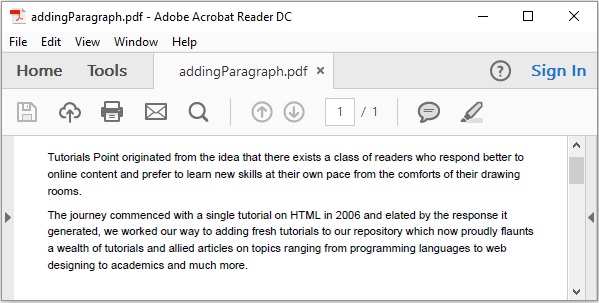
iText - Adding a List
In this chapter, we will see how to create a PDF document and add a list to it using the iText library.
Creating a List
You can create an empty PDF Document by instantiating the Document class. While instantiating this class, you need to pass a PdfDocument object as a parameter, to its constructor. Then, to add a list to the document, you need to instantiate the List class and add this object to the document using the add() method.
Following are the steps to create a PDF document and add a List in it.
Step 1: Creating a PdfWriter object
The PdfWriter class represents the DocWriter for a PDF. This class belongs to the package com.itextpdf.kernel.pdf. The constructor of this class accepts a string, representing the path of the file where the PDF is to be created.
Instantiate the PdfWriter class by passing a string value (representing the path where you need to create a PDF) to its constructor, as shown below.
// Creating a PdfWriter String dest = "C:/itextExamples/addingList.pdf"; PdfWriter writer = new PdfWriter(dest);
When the object of this type is passed to a PdfDocument (class), every element added to this document will be written to the file specified.
Step 2: Creating a PdfDocument object
The PdfDocument class is the class that represents the PDF Document in iText, this class belongs to the package com.itextpdf.kernel.pdf. To instantiate this class (in writing mode), you need to pass an object of the class PdfWriter to its constructor.
Instantiate the PdfDocument class by passing the above created PdfWriter object to its constructor, as shown below.
// Creating a PdfDocument PdfDocument pdfDoc = new PdfDocument(writer);
Once a PdfDocument object is created, you can add various elements like page, font, file attachment, and event handler using the respective methods provided by its class.
Step 3: Creating the Document object
The Document class of the package com.itextpdf.layout is the root element while creating a self-sufficient PDF. One of the constructors of this class accepts an object of the class PdfDocument.
Instantiate the Document class by passing the object of the class PdfDocument created in the previous steps, as shown below.
// Creating a Document Document document = new Document(pdfDoc);
Step 4: Creating a List object
The List class represents a series of objects that are vertically outlined. It belongs to the package com.itextpdf.layout.element.
Instantiate the List class as shown below.
// Creating a list List list = new List();
Step 5: Adding elements to the list
Add contents to the list object using the add() method of the List class by passing String values, as shown below.
// Add elements to the list
list.add("Java");
list.add("JavaFX");
list.add("Apache Tika");
list.add("OpenCV");
Step 6: Adding List to the document
Add the list object created in the previous step using the add() method of the Document class, as shown below.
// Adding list to the document document.add(list);
Step 7: Closing the Document
Close the document using the close() method of the Document class as shown below.
// Closing the document document.close();
Example
The following Java program demonstrates how to create a PDF document and add a list to it using the iText library. It creates a PDF document with the name addingList.pdf, adds a list to it, and saves it in the path C:/itextExamples/.
Save this code in a file with name AddingList.java.
import com.itextpdf.kernel.pdf.PdfDocument;
import com.itextpdf.kernel.pdf.PdfWriter;
import com.itextpdf.layout.Document;
import com.itextpdf.layout.element.List;
import com.itextpdf.layout.element.Paragraph;
public class AddingList {
public static void main(String args[]) throws Exception {
// Creating a PdfWriter
String dest = "C:/itextExamples/addngList.pdf";
PdfWriter writer = new PdfWriter(dest);
// Creating a PdfDocument
PdfDocument pdf = new PdfDocument(writer);
// Creating a Document
Document document = new Document(pdf);
// Creating a Paragraph
Paragraph paragraph = new Paragraph("Tutorials Point provides the following tutorials");
// Creating a list
List list = new List();
// Add elements to the list
list.add("Java");
list.add("JavaFX");
list.add("Apache Tika");
list.add("OpenCV");
list.add("WebGL");
list.add("Coffee Script");
list.add("Java RMI");
list.add("Apache Pig");
// Adding paragraph to the document
document.add(paragraph);
// Adding list to the document
document.add(list);
// Closing the document
document.close();
System.out.println("List added");
}
}
Compile and execute the saved Java file from the Command prompt using the following commands −
javac AddingList.java java AddingList
Upon execution, the above program creates a PDF document, displaying the following message.
List added
If you verify the specified path, you can find the created PDF document, as shown below.
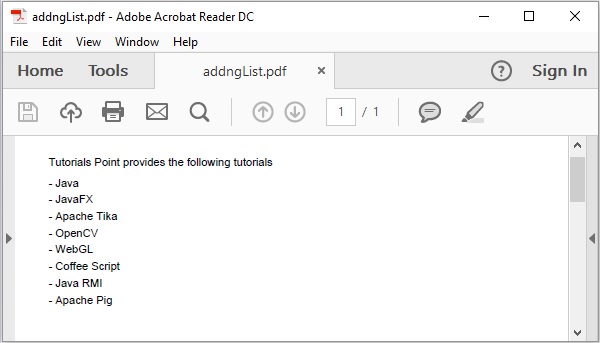
iText - Adding a Table
In this chapter, we will see how to create a PDF document and add a table to it using the iText library.
Adding a Table to a Pdf
You can create an empty PDF Document by instantiating the Document class. While instantiating this class, you need to pass a PdfDocument object as a parameter to its constructor. Then, to add a table to the document, you need to instantiate the Table class and add this object to the document using the add() method.
Following are the steps to create a PDF document with a Table in it.
Step 1: Creating a PdfWriter object
The PdfWriter class represents the DocWriter for a PDF. This class belongs to the package com.itextpdf.kernel.pdf. The constructor of this class accepts a string, representing the path of the file where the PDF is to be created.
Instantiate the PdfWriter class by passing a string value (representing the path where you need to create a PDF) to its constructor, as shown below.
// Creating a PdfWriter String dest = "C:/itextExamples/addingTable.pdf"; PdfWriter writer = new PdfWriter(dest);
When the object of this type is passed to a PdfDocument (class), every element added to this document will be written to the file specified.
Step 2: Creating a PdfDocument object
The PdfDocument class is the class that represents the PDF Document in iText. This class belongs to the package com.itextpdf.kernel.pdf. To instantiate this class (in writing mode), you need to pass an object of the class PdfWriter to its constructor.
Instantiate the PdfDocument class by passing the above created PdfWriter object to its constructor, as shown below.
// Creating a PdfDocument PdfDocument pdfDoc = new PdfDocument(writer);
Once a PdfDocument object is created, you can add various elements like page, font, file attachment, and event handler using the respective methods provided by its class.
Step 3: Creating the Document object
The Document class of the package com.itextpdf.layout is the root element while creating a self-sufficient PDF. One of the constructors of this class accepts an object of the class PdfDocument.
Instantiate the Document class by passing the object of the class PdfDocument created in the previous steps, as shown below.
// Creating a Document Document document = new Document(pdfDoc);
Step 4: Creating a Table object
The Table class represents a two-dimensional grid filled with cells ordered in rows and columns. It belongs to the package com.itextpdf.layout.element.
Instantiate the Table class as shown below.
// Creating a table object
float [] pointColumnWidths = {150F, 150F, 150F};
Table table = new Table(pointColumnWidths);
Step 5: Adding cells to the table
Create a cell object by instantiating the Cell class of the package com.itextpdf.layout.element. Add the contents of the cell using the add() method of this class.
Finally, to add this cell to the table, call the addCell() method of the Table class and pass the cell object as a parameter to this method, as shown below.
// Adding cell 1 to the table
Cell cell1 = new Cell(); // Creating a cell
cell1.add("Name"); // Adding content to the cell
table.addCell(cell1); // Adding cell to the table
// Adding cell 2 to the table Cell
cell2 = new Cell(); // Creating a cell
cell2.add("Raju"); // Adding content to the cell
table.addCell(cell2); // Adding cell to the table
Step 6: Adding table to the document
Add the table object created in the previous step using the add() method of the Document class as shown below.
// Adding list to the document document.add(table);
Step 7: Closing the Document
Close the document using the close() method of the Document class, as shown below.
// Closing the document document.close();
Example
The following Java program demonstrates how to create a PDF document and add a table to it using the iText library. It creates a PDF document with the name addingTable.pdf, adds a table to it, and saves it in the path C:/itextExamples/
Save this code in a file with the name AddingTable.java.
import com.itextpdf.kernel.pdf.PdfDocument;
import com.itextpdf.kernel.pdf.PdfWriter;
import com.itextpdf.layout.Document;
import com.itextpdf.layout.element.Cell;
import com.itextpdf.layout.element.Table;
public class AddingTable {
public static void main(String args[]) throws Exception {
// Creating a PdfDocument object
String dest = "C:/itextExamples/addingTable.pdf";
PdfWriter writer = new PdfWriter(dest);
// Creating a PdfDocument object
PdfDocument pdf = new PdfDocument(writer);
// Creating a Document object
Document doc = new Document(pdf);
// Creating a table
float [] pointColumnWidths = {150F, 150F, 150F};
Table table = new Table(pointColumnWidths);
// Adding cells to the table
table.addCell(new Cell().add("Name"));
table.addCell(new Cell().add("Raju"));
table.addCell(new Cell().add("Id"));
table.addCell(new Cell().add("1001"));
table.addCell(new Cell().add("Designation"));
table.addCell(new Cell().add("Programmer"));
// Adding Table to document
doc.add(table);
// Closing the document
doc.close();
System.out.println("Table created successfully..");
}
}
Compile and execute the saved Java file from the Command prompt using the following commands −
javac AddingTable.java java AddingTable
Upon execution, the above program creates a PDF document, displaying the following message.
Table created successfully..
If you verify the specified path, you can find the created PDF document, as shown below.
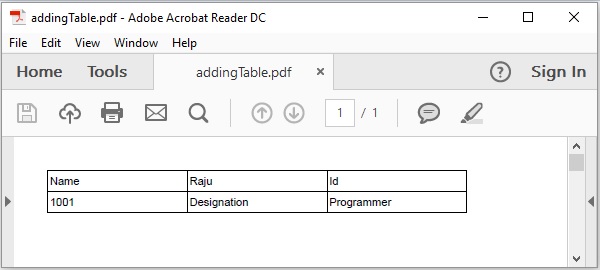
iText - Formatting Cell Contents
In this chapter, we will see how to create a PDF document and add a table and format the contents of a cell in the table using the iText library.
Formatting the Cells in a Table
You can create an empty PDF Document by instantiating the Document class. While instantiating this class, you need to pass a PdfDocument object as a parameter, to its constructor. Then, to add a table to the document, you need to instantiate the Table class and add this object to the document using the add() method. You can format the contents of a cell in a table using the methods of the Cell class.
Following are the steps to format the contents of a cell in a table.
Step 1: Creating a PdfWriter object
The PdfWriter class represents the DocWriter for a PDF. This class belongs to the package com.itextpdf.kernel.pdf. The constructor of this class accepts a string, representing the path of the file where the PDF is to be created.
Instantiate the PdfWriter class by passing a string value (representing the path where you need to create a PDF) to its constructor, as shown below.
// Creating a PdfWriter String dest = "C:/itextExamples/addingBackground.pdf"; PdfWriter writer = new PdfWriter(dest);
When an object of this type is passed to a PdfDocument (class), every element added to this document will be written to the file specified.
Step 2: Creating a PdfDocument object
The PdfDocument class is the class that represents the PDFDocument in iText. This class belongs to the package com.itextpdf.kernel.pdf. To instantiate this class (in writing mode), you need to pass an object of the class PdfWriter to its constructor.
Instantiate the PdfDocument class by passing the above created PdfWriter object to its constructor, as shown below.
// Creating a PdfDocument PdfDocument pdfDoc = new PdfDocument(writer);
Once a PdfDocument object is created, you can add various elements like page, font, file attachment, and event handler using the respective methods provided by its class.
Step 3: Creating the Document object
The Document class of the package com.itextpdf.layout is the root element while creating a self-sufficient PDF. One of the constructors of this class accepts an object of the class PdfDocument.
Instantiate the Document class by passing the object of the class PdfDocument created in the previous steps, as shown below.
// Creating a Document Document document = new Document(pdfDoc);
Step 4: Creating a Table object
The Table class represents a two-dimensional grid filled with cells, ordered in rows and columns. It belongs to the package com.itextpdf.layout.element.
Instantiate the Table class as shown below.
// Creating a table
float [] pointColumnWidths = {200F, 200F};
Table table = new Table(pointColumnWidths);
Step 5: Creating cells
Create a cell object by instantiating the Cell class of the package com.itextpdf.layout.element. Add the contents of the cell using the add() method of the Cell class, as shown below.
// Adding cell 1 to the table
Cell cell1 = new Cell(); // Creating a cell
cell1.add("Name"); // Adding content to the cell
// Adding cell 2 to the table
Cell cell2 = new Cell(); // Creating a cell
cell2.add("Raju"); // Adding content to the cell
Step 6: Adding Background to the cell
Once you created the cell and added contents to it, you can format the cell. For example, you can set its background, align the text inside the cell, change the text color, etc., using different methods of the cell class such as setBackgroundColor(), setBorder(), setTextAlignment().
You can set the background color, border, and text alignment to the cell created in the previous step, as shown below.
c1.setBackgroundColor(Color.DARK_GRAY); // Setting background color to cell1 c1.setBorder(Border.NO_BORDER); // Setting border to cell1 c1.setTextAlignment(TextAlignment.CENTER); // Setting text alignment to cell1
Step 7: Adding cell to the table
Finally, to add this cell to the table, call the addCell() method of the Table class and pass the cell object as a parameter to this method, as shown below.
table.addCell(c1);
Step 8: Adding table to the document
Add the table object created in the previous step using the add() method of the Document class as shown below.
// Adding list to the document document.add(table);
Step 9: Closing the Document
Close the document using the close() method of the Document class, as shown below.
// Closing the document document.close();
Example
The following Java program demonstrates how to format the contents of a cell in a table using the iText library. It creates a PDF document with the name addingBackground.pdf, adds a table to it, formats the contents of its cells, and saves it in the path C:/itextExamples/
Save this code in a file with the name BackgroundToTable.java.
import com.itextpdf.kernel.color.Color;
import com.itextpdf.kernel.pdf.PdfDocument;
import com.itextpdf.kernel.pdf.PdfWriter;
import com.itextpdf.layout.Document;
import com.itextpdf.layout.border.Border;
import com.itextpdf.layout.element.Cell;
import com.itextpdf.layout.element.Table;
import com.itextpdf.layout.property.TextAlignment;
public class BackgroundToTable {
public static void main(String args[]) throws Exception {
// Creating a PdfWriter object
String dest = "C:/itextExamples/addingBackground.pdf";
PdfWriter writer = new PdfWriter(dest);
// Creating a PdfDocument object
PdfDocument pdfDoc = new PdfDocument(writer);
// Creating a Document object
Document doc = new Document(pdfDoc);
// Creating a table
float [] pointColumnWidths = {200F, 200F};
Table table = new Table(pointColumnWidths);
// Populating row 1 and adding it to the table
Cell c1 = new Cell(); // Creating cell 1
c1.add("Name"); // Adding name to cell 1
c1.setBackgroundColor(Color.DARK_GRAY); // Setting background color
c1.setBorder(Border.NO_BORDER); // Setting border
c1.setTextAlignment(TextAlignment.CENTER); // Setting text alignment
table.addCell(c1); // Adding cell 1 to the table
Cell c2 = new
Cell();
c2.add("Raju");
c2.setBackgroundColor(Color.GRAY);
c2.setBorder(Border.NO_BORDER);
c2.setTextAlignment(TextAlignment.CENTER);
table.addCell(c2);
// Populating row 2 and adding it to the table
Cell c3 = new Cell();
c3.add("Id");
c3.setBackgroundColor(Color.WHITE);
c3.setBorder(Border.NO_BORDER);
c3.setTextAlignment(TextAlignment.CENTER);
table.addCell(c3);
Cell c4 = new Cell();
c4.add("001");
c4.setBackgroundColor(Color.WHITE);
c4.setBorder(Border.NO_BORDER);
c4.setTextAlignment(TextAlignment.CENTER);
table.addCell(c4);
// Populating row 3 and adding it to the table
Cell c5 = new Cell();
c5.add("Designation");
c5.setBackgroundColor(Color.DARK_GRAY);
c5.setBorder(Border.NO_BORDER);
c5.setTextAlignment(TextAlignment.CENTER);
table.addCell(c5);
Cell c6 = new Cell();
c6.add("Programmer");
c6.setBackgroundColor(Color.GRAY);
c6.setBorder(Border.NO_BORDER);
c6.setTextAlignment(TextAlignment.CENTER);
table.addCell(c6);
// Adding Table to document
doc.add(table);
// Closing the document
doc.close();
System.out.println("Background added successfully..");
}
}
Compile and execute the saved Java file from the Command prompt using the following commands −
javac BackgroundToTable.java java BackgroundToTable
Upon execution, the above program creates a PDF document, displaying the following message.
Background added successfully..
If you verify the specified path, you can find the created PDF document, as shown below.
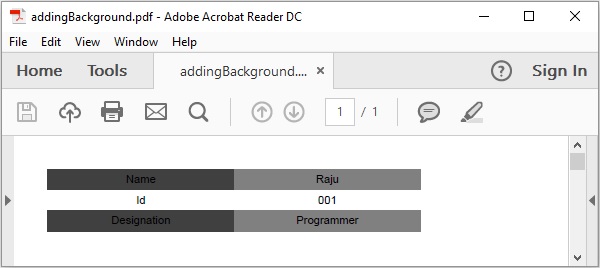
iText - Formatting the Borders of a Cell
In this chapter, we will see how to format the borders of a cell in a table using iText library.
Formatting the Borders of a Cell
You can create an empty PDF Document by instantiating the Document class. While instantiating this class, you need to pass a PdfDocument object as a parameter to its constructor.
Then, to add a table to the document, you need to instantiate the Table class and add this object to the document using the add() method.
You can add various types of borders like DashedBorder, SolidBorder, DottedBorder, DoubleBorder, RoundDotsBorder, etc. with various colors using the setBorder() method of the Cell class.
Following are the steps to format the borders of a cell in a table.
Step 1: Creating a PdfWriter object
The PdfWriter class represents the DocWriter for a PDF. This class belongs to the package com.itextpdf.kernel.pdf. The constructor of this class accepts a string, representing the path of the file where the PDF is to be created.
Instantiate the PdfWriter class by passing a string value (representing the path where you need to create a PDF) to its constructor, as shown below.
// Creating a PdfWriter String dest = "C:/itextExamples/coloredBorders.pdf"; PdfWriter writer = new PdfWriter(dest);
When an object of this type is passed to a PdfDocument (class), every element added to this document will be written to the file specified.
Step 2: Creating a PdfDocument object
The PdfDocument class is the class that represents the PDFDocument in iText. This class belongs to the package com.itextpdf.kernel.pdf. To instantiate this class (in writing mode), you need to pass an object of the class PdfWriter to its constructor.
Instantiate the PdfDocument class by passing the above created PdfWriter object to its constructor, as shown below.
// Creating a PdfDocument PdfDocument pdfDoc = new PdfDocument(writer);
Once a PdfDocument object is created, you can add various elements like page, font, file attachment, and event handler using the respective methods provided by its class.
Step 3: Creating the Document object
The Document class of the package com.itextpdf.layout is the root element while creating a self-sufficient PDF. One of the constructors of this class accepts an object of the class PdfDocument.
Instantiate the Document class by passing the object of the class PdfDocument created in the previous steps, as shown below.
// Creating a Document Document document = new Document(pdfDoc);
Step 4: Creating a Table object
The Table class represents a two-dimensional grid filled with cells ordered in rows and columns. It belongs to the package com.itextpdf.layout.element.
Instantiate the Table class as shown below.
// Creating a table
float [] pointColumnWidths = {200F, 200F};
Table table = new Table(pointColumnWidths);
Step 5: Creating cells
Create a cell object by instantiating the Cell class of the package com.itextpdf.layout.element add the contents of the cell using the add() method of the Cell class, as shown below.
// Adding cell 1 to the table
Cell cell1 = new Cell(); // Creating a cell
cell1.add("Name"); // Adding content to the cell
Step 6: Formatting the border of the cell
The iText library provides various classes representing the border such as DashedBorder, SolidBorder, DottedBorder, DoubleBorder, RoundDotsBorder, etc.
The constructors of these classes accept two parameters: a color object representing the color of the border and an integer representing the width of the border.
Choose one of this border types and instantiate the respective border by passing the color object and an integer representing the width, as shown below.
Border b1 = new DashedBorder(Color.RED, 3);
Now, set the border of the cell using the setBorder() method of the cell class. This method accepts an object of the type Border as a parameter.
Set the border of the cell by passing the above created Border object as a parameter to the setBorder() method as shown below.
c1.setBorder(b1)
Finally, to add this cell to the table, call the addCell() method of the Table class and pass the cell object as a parameter to this method, as shown below.
table.addCell(c1);
Step 7: Adding table to the document
Add the table object created in the previous step using the add() method of the Document class, as shown below.
// Adding list to the document document.add(table);
Step 8: Closing the Document
Close the document using the close() method of the Document class, as shown below.
// Closing the document document.close();
Example
The following Java program demonstrates how to format the border of a cell in a table using the iText library. It creates a PDF document with the name coloredBorders.pdf, adds a table to it, formats the contents of its cells, and saves it in the path C:/itextExamples/
Save this code in a file with the name FormatedBorders.java.
import com.itextpdf.kernel.color.Color;
import com.itextpdf.kernel.pdf.PdfDocument;
import com.itextpdf.kernel.pdf.PdfWriter;
import com.itextpdf.layout.Document;
import com.itextpdf.layout.border.Border;
import com.itextpdf.layout.border.DashedBorder;
import com.itextpdf.layout.border.DottedBorder;
import com.itextpdf.layout.border.DoubleBorder;
import com.itextpdf.layout.border.RoundDotsBorder;
import com.itextpdf.layout.border.SolidBorder;
import com.itextpdf.layout.element.Cell;
import com.itextpdf.layout.element.Table;
import com.itextpdf.layout.property.TextAlignment;
public class FormatedBorders {
public static void main(String args[]) throws Exception {
// Creating a PdfWriter object
String dest = "C:/itextExamples/coloredBorders.pdf";
PdfWriter writer = new
PdfWriter(dest);
// Creating a PdfDocument object
PdfDocument pdfDoc = new PdfDocument(writer);
// Creating a Document object
Document doc = new Document(pdfDoc);
// Creating a table
float [] pointColumnWidths = {200F, 200F};
Table table = new Table(pointColumnWidths);
// Adding row 1 to the table
Cell c1 = new Cell();
// Adding the contents of the cell
c1.add("Name");
// Setting the back ground color of the cell
c1.setBackgroundColor(Color.DARK_GRAY);
// Instantiating the Border class
Border b1 = new DashedBorder(Color.RED, 3);
// Setting the border of the cell
c1.setBorder(b1);
// Setting the text alignment
c1.setTextAlignment(TextAlignment.CENTER);
// Adding the cell to the table
table.addCell(c1);
Cell c2 = new Cell();
c2.add("Raju");
c1.setBorder(new SolidBorder(Color.RED, 3));
c2.setTextAlignment(TextAlignment.CENTER);
table.addCell(c2);
// Adding row 2 to the table
Cell c3 = new Cell();
c3.add("Id");
c3.setBorder(new DottedBorder(Color.DARK_GRAY, 3));
c3.setTextAlignment(TextAlignment.CENTER);
table.addCell(c3);
Cell c4 = new Cell();
c4.add("001");
c4.setBorder(new DoubleBorder(Color.DARK_GRAY, 3));
c4.setTextAlignment(TextAlignment.CENTER);
table.addCell(c4);
// Adding row 3 to the table
Cell c5 = new Cell();
c5.add("Designation");
c5.setBorder(new RoundDotsBorder(Color.RED, 3));
c5.setTextAlignment(TextAlignment.CENTER);
table.addCell(c5);
Cell c6 = new Cell();
c6.add("Programmer");
c6.setBorder(new RoundDotsBorder(Color.RED, 3));
c6.setTextAlignment(TextAlignment.CENTER);
table.addCell(c6);
// Adding Table to document
doc.add(table);
// Closing the document
doc.close();
System.out.println("Borders added successfully..");
}
}
Compile and execute the saved Java file from the Command prompt using the following commands −
javac FormatedBorders.java java FormatedBorders
Upon execution, the above program creates a PDF document, displaying the following message.
Borders added successfully
If you verify the specified path, you can find the created PDF document, as shown below.
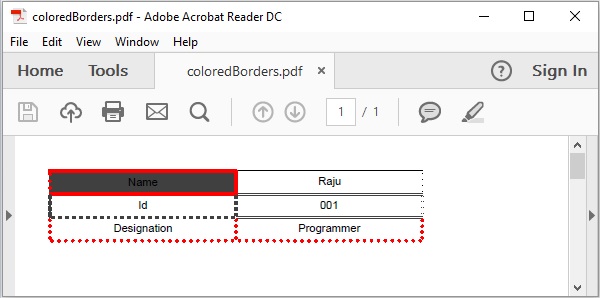
iText - Adding Image to a Table
In this chapter, we will see how to add an image to a table in a PDF document using the iText library.
Adding an Image to a Table
You can create an empty PDF document by instantiating the Document class. While instantiating this class, you need to pass a PdfDocument object as a parameter, to its constructor. Then, to add a table to the document, you need to instantiate the Table class and add this object to the document using the add() method.
To add an image to this table, you need to instantiate the Cell class, create and an object of the image that is required to be added, add the image to the cell object using the add() method of the Cell class.
Following are the steps to insert an image into the cell of a table.
Step 1: Creating a PdfWriter object
The PdfWriter class represents the Doc Writer for a PDF, this class belongs to the package com.itextpdf.kernel.pdf. The constructor of this class accepts a string, representing the path of the file where the PDF is to be created.
Instantiate PdfWriter class by passing a string value representing the path where you need to create a PDF, to its constructor, as shown below.
// Creating a PdfWriter String dest = "C:/itextExamples/addingImage.pdf"; PdfWriter writer = new PdfWriter(dest);
When an object of this type is passed to a PdfDocument (class), every element added to this document will be written to the file specified.
Step 2: Creating a PdfDocument object
The PdfDocument class is the class that represents the PDF Document in iText. This class belongs to the package com.itextpdf.kernel.pdf. To instantiate this class (in writing mode), you need to pass an object of the class PdfWriter to its constructor.
Instantiate the PdfDocument class by passing the above created PdfWriter object to its constructor, as shown below.
// Creating a PdfDocument PdfDocument pdfDoc = new PdfDocument(writer);
Once a PdfDocument object is created, you can add various elements like page, font, file attachment, and event handler using the respective methods provided by its class.
Step 3: Creating the Document object
The Document class of the package com.itextpdf.layout is the root element while creating a self-sufficient PDF. One of the constructors of this class accepts an object of the class PdfDocument.
Instantiate the Document class by passing the object of the class PdfDocument created in the previous steps, as shown below.
// Creating a Document Document document = new Document(pdfDoc);
Step 4: Creating a Table object
The Table class represents a two-dimensional grid filled with cells, ordered in rows and columns. It belongs to the package com.itextpdf.layout.element.
Instantiate the Table class as shown below.
// Creating a table
float [] pointColumnWidths = {200F, 200F};
Table table = new Table(pointColumnWidths);
Step 5: Creating the cell
Create a cell object by instantiating the Cell class of the package com.itextpdf.layout, as shown below.
// Adding cell to the table Cell cell = new Cell(); // Creating a cell
Step 6: Creating an Image
To create the image object, first of all, create an ImageData object using the create() method of the ImageDataFactory class. As a parameter of this method, pass a string parameter representing the path of the image, as shown below.
// Creating an ImageData object String imageFile = "C:/itextExamples/javafxLogo.jpg"; ImageData data = ImageDataFactory.create(imageFile);
Now, instantiate the Image class of the com.itextpdf.layout.element package. While instantiating, pass the ImageData object created above, as a parameter to its constructor, as shown below.
// Creating an Image object Image img = new Image(data);
Add the image object to the cell using the add() method of the cell class, as shown below.
// Adding image to the cell cell.add(img.setAutoScale(true));
Step 7: Adding cell to the table
Finally, to add this cell to the table, call the addCell() method of the Table class and pass the cell object as a parameter to this method, as shown below.
table.addCell(cell);
Step 8: Adding table to the document
Add the table object created in the previous step using the add() method of the Document class, as shown below.
// Adding list to the document document.add(table);
Step 9: Closing the Document
Close the document using the close() method of the Document class, as shown below.
// Closing the document document.close();
Example
The following Java program demonstrates how to add an image to a cell of a table in a PDF document using the iText library. It creates a PDF document with the name addingImage.pdf, adds a table to it, inserts an image (javafxLogo.jpg) to one of its cells, and saves it in the path C:/itextExamples/.
Save this code in a file with the name AddingImageToTable.java.
import com.itextpdf.io.image.ImageData;
import com.itextpdf.io.image.ImageDataFactory;
import com.itextpdf.kernel.pdf.PdfDocument;
import com.itextpdf.kernel.pdf.PdfWriter;
import com.itextpdf.layout.Document;
import com.itextpdf.layout.element.Cell;
import com.itextpdf.layout.element.Image;
import com.itextpdf.layout.element.Table;
public class a3AddingImageToTable {
public static void main(String args[]) throws Exception {
// Creating a PdfWriter object
String dest = "C:/itextExamples/addingImage.pdf";
PdfWriter writer = new PdfWriter(dest);
// Creating a PdfDocument object
PdfDocument pdfDoc = new PdfDocument(writer);
// Creating a Document object
Document doc = new Document(pdfDoc);
// Creating a table
float [] pointColumnWidths = {150f, 150f};
Table table = new Table(pointColumnWidths);
// Populating row 1 and adding it to the table
Cell cell1 = new Cell();
cell1.add("Tutorial ID");
table.addCell(cell1);
Cell cell2 = new Cell();
cell2.add("1");
table.addCell(cell2);
// Populating row 2 and adding it to the table
Cell cell3 = new Cell();
cell3.add("Tutorial Title");
table.addCell(cell3);
Cell cell4 = new Cell();
cell4.add("JavaFX");
table.addCell(cell4);
// Populating row 3 and adding it to the table
Cell cell5 = new Cell();
cell5.add("Tutorial Author");
table.addCell(cell5);
Cell cell6 = new Cell();
cell6.add("Krishna Kasyap");
table.addCell(cell6);
// Populating row 4 and adding it to the table
Cell cell7 = new Cell();
cell7.add("Submission date");
table.addCell(cell7);
Cell cell8 = new Cell();
cell8.add("2016-07-06");
table.addCell(cell8);
// Populating row 5 and adding it to the table
Cell cell9 = new Cell();
cell9.add("Tutorial Icon");
table.addCell(cell9);
// Creating the cell10
Cell cell10 = new Cell();
// Creating an ImageData object
String imageFile = "C:/itextExamples/javafxLogo.jpg";
ImageData data = ImageDataFactory.create(imageFile);
// Creating the image
Image img = new Image(data);
// Adding image to the cell10
cell10.add(img.setAutoScale(true));
// Adding cell110 to the table
table.addCell(cell10);
// Adding Table to document
doc.add(table);
// Closing the document
doc.close();
System.out.println("Image added to table successfully..");
}
}
Compile and execute the saved Java file from the Command prompt using the following commands −
javac AddingImageToTable.java java AddingImageToTable
Upon execution, the above program creates a PDF document, displaying the following message.
Image added to table successfully..
If you verify the specified path, you can find the created PDF document, as shown below.
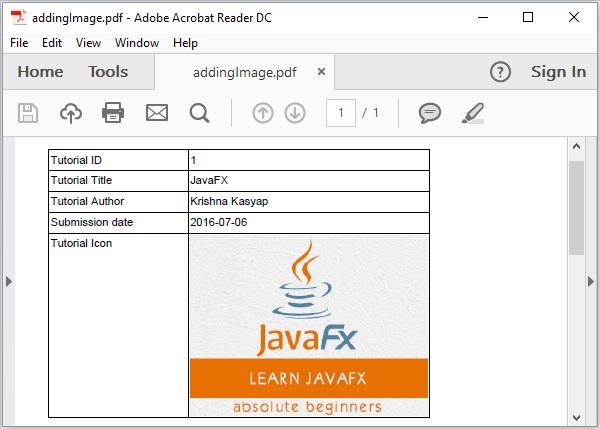
iText - Nested Table
In this chapter, we will see how to add a nested table to a table in a PDF document using the iText library.
Adding Nested Tables in a Pdf
You can create an empty PDF Document by instantiating the Document class. While instantiating this class, you need to pass a PdfDocument object as a parameter, to its constructor. Then, to add a table to the document, you need to instantiate the Table class and add this object to the document using the add() method.
To add a table to this table, you need to create another table (nested table), and pass it to the cell object using the add() method of the Cell class.
Following are the steps to insert a table into the cell of a table.
Step 1: Creating a PdfWriter object
The PdfWriter class represents the DocWriter for a PDF. This class belongs to the package com.itextpdf.kernel.pdf. The constructor of this class accepts a string, representing the path of the file where the PDF is to be created.
Instantiate the PdfWriter class by passing a string value (representing the path where you need to create a PDF) to its constructor, as shown below.
// Creating a PdfWriter String dest = "C:/itextExamples/addingNestedTable.pdf"; PdfWriter writer = new PdfWriter(dest);
When an object of this type is passed to a PdfDocument (class), every element added to this document will be written to the file specified.
Step 2: Creating a PdfDocument object
The PdfDocument class is the class that represents the PDF Document in iText. This class belongs to the package com.itextpdf.kernel.pdf. To instantiate this class (in writing mode), you need to pass an object of the class PdfWriter to its constructor.
Instantiate the PdfDocument class by passing the above created PdfWriter object to its constructor, as shown below.
// Creating a PdfDocument PdfDocument pdfDoc = new PdfDocument(writer);
Once a PdfDocument object is created, you can add various elements like page, font, file attachment, and event handler using the respective methods provided by its class.
Step 3: Creating the Document object
The Document class of the package com.itextpdf.layout is the root element while creating a self-sufficient PDF. One of the constructors of this class accepts an object of the class PdfDocument.
Instantiate the Document class by passing the object of the class PdfDocument created in the previous steps, as shown below.
// Creating a Document Document document = new Document(pdfDoc);
Step 4: Creating a Table object
The Table class represents a two-dimensional grid filled with cells, ordered in rows and columns. It belongs to the package com.itextpdf.layout.element.
Instantiate the Table class as shown below.
// Creating a table
float [] pointColumnWidths = {200F, 200F};
Table table = new Table(pointColumnWidths);
Step 5: Creating the cell
Create a cell object by instantiating the Cell class of the package com.itextpdf.layout, as shown below.
// Adding cell to the table Cell contact = new Cell(); // Creating a cell
Step 6: Creating Nested table
After creating the cell, create a nested table, and populate its cells, as shown below.
// Creating nested table for contact
float [] pointColumnWidths2 = {150f, 150f};
Table nestedTable = new Table(pointColumnWidths2);
// Populating row 1 and adding it to the nested table
Cell nested1 = new Cell();
nested1.add("Phone");
nestedTable.addCell(nested1);
Cell nested2 = new Cell();
nested2.add("9848022338");
nestedTable.addCell(nested2);
// Populating row 2 and adding it to the nested table
Cell nested3 = new Cell();
nested3.add("email");
nestedTable.addCell(nested3);
Cell nested4 = new Cell();
nested4.add("Raju123@gmail.com");
nestedTable.addCell(nested4);
// Populating row 3 and adding it to the nested table
Cell nested5 = new Cell();
nested5.add("Address");
nestedTable.addCell(nested5);
Cell nested6 = new Cell();
nested6.add("Hyderabad");
nestedTable.addCell(nested6);
Step 7: Adding Nested table to the cell
Now, add the above created nested table to the cell of the parent (container) table using the add() method of the Cell class. And, add this cell to the parent table using the addCell() method of the Table class, as shown below.
contact.add(nestedTable); table.addCell(contact);
Step 8: Adding table to the document
Add the table object created in the previous step using the add() method of the Document class, as shown below.
// Adding list to the document document.add(table);
Step 9: Closing the Document
Close the document using the close() method of the Document class, as shown below.
// Closing the document document.close();
Example
The following Java program demonstrates how to add a table to a cell of a table (nested table) in a PDF document using the iText library. It creates a PDF document with the name addingNestedTable.pdf, adds a table to it, inserts another table to one of its cells, and saves it in the path C:/itextExamples/.
Save this code in a file with the name AddNestedTable.java.
import com.itextpdf.kernel.pdf.PdfDocument;
import com.itextpdf.kernel.pdf.PdfWriter;
import com.itextpdf.layout.Document;
import com.itextpdf.layout.element.Cell;
import com.itextpdf.layout.element.Table;
public class a4AddNestedTablesPdf {
public static void main(String args[]) throws Exception {
// Creating a PdfWriter object
String dest = "C:/itextExamples/addingNestedTable.pdf";
PdfWriter writer = new PdfWriter(dest);
// Creating a PdfDocument object
PdfDocument pdfDoc = new PdfDocument(writer);
// Creating a Document object
Document doc = new Document(pdfDoc);
// Creating a table
float [] pointColumnWidths1 = {150f, 150f};
Table table = new Table(pointColumnWidths1);
// Populating row 1 and adding it to the table
Cell cell1 = new Cell();
cell1.add("Name");
table.addCell(cell1);
Cell cell2 = new Cell();
cell2.add("Raju");
table.addCell(cell2);
// Populating row 2 and adding it to the table
Cell cell3 = new Cell();
cell3.add("Id");
table.addCell(cell3);
Cell cell4 = new Cell();
cell4.add("1001");
table.addCell(cell4);
// Populating row 3 and adding it to the table
Cell cell5 = new Cell();
cell5.add("Designation");
table.addCell(cell5);
Cell cell6 = new Cell();
cell6.add("Programmer");
table.addCell(cell6);
// Creating nested table for contact
float [] pointColumnWidths2 = {150f, 150f};
Table nestedTable = new Table(pointColumnWidths2);
// Populating row 1 and adding it to the nested table
Cell nested1 = new Cell();
nested1.add("Phone");
nestedTable.addCell(nested1);
Cell nested2 = new Cell();
nested2.add("9848022338");
nestedTable.addCell(nested2);
// Populating row 2 and adding it to the nested table
Cell nested3 = new Cell();
nested3.add("email");
nestedTable.addCell(nested3);
Cell nested4 = new Cell();
nested4.add("Raju123@gmail.com");
nestedTable.addCell(nested4);
// Populating row 3 and adding it to the nested table
Cell nested5 = new Cell();
nested5.add("Address");
nestedTable.addCell(nested5);
Cell nested6 = new Cell();
nested6.add("Hyderabad");
nestedTable.addCell(nested6);
// Adding table to the cell
Cell cell7 = new Cell();
cell7.add("Contact");
table.addCell(cell7);
Cell cell8 = new Cell();
cell8.add(nestedTable);
table.addCell(cell8);
// Adding table to the document
doc.add(table);
// Closing the document
doc.close();
System.out.println("Nested Table Added successfully..");
}
}
Compile and execute the saved Java file from the Command prompt using the following commands −
javac AddNestedTable.java java AddNestedTable
Upon execution, the above program creates a PDF document displaying the following message.
Nested Table Added successfully..
If you verify the specified path, you can find the created PDF document, as shown below.
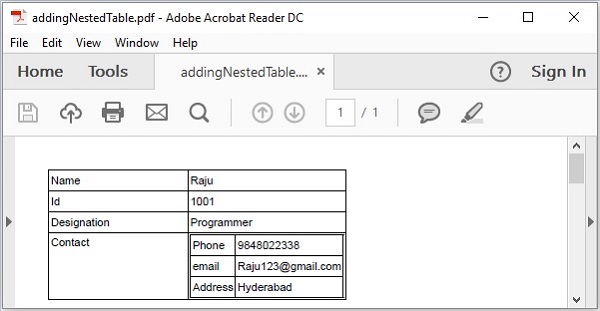
iText - Adding Lists to a Table
In this chapter, we will see how to add a list to a table in a PDF document using the iText library.
Adding Lists to a Table in a PDF
You can create an empty PDF Document by instantiating the Document class. While instantiating this class, you need to pass a PdfDocument object as a parameter to its constructor. Then, to add a table to the document, you need to instantiate the Table class and add this object to the document using the add() method.
To add a list to the table, you need to instantiate the List class of the com.itextpdf.layout.element package and insert it into the cell object using the add() method of the Cell class.
Following are the steps to add a list to the cell of a table.
Step 1: Creating a PdfWriter object
The PdfWriter class represents the Doc Writer for a PDF. This class belongs to the package com.itextpdf.kernel.pdf. The constructor of this class accepts a string, representing the path of the file where the PDF is to be created.
Instantiate the PdfWriter class by passing a string value (representing the path where you need to create a PDF) to its constructor, as shown below
// Creating a PdfWriter String dest = "C:/itextExamples/addingObjects.pdf"; PdfWriter writer = new PdfWriter(dest);
When an object of this type is passed to a PdfDocument (class), every element added to this document will be written to the file specified.
Step 2: Creating a PdfDocument object
The PdfDocument class is the class that represents the PDF Document in iText. This class belongs to the package com.itextpdf.kernel.pdf. To instantiate this class (in writing mode), you need to pass an object of the class PdfWriter to its constructor.
Instantiate the PdfDocument class by passing the above created PdfWriter object to its constructor, as shown below.
// Creating a PdfDocument PdfDocument pdfDoc = new PdfDocument(writer);
Once a PdfDocument object is created, you can add various elements like page, font, file attachment, and event handler using the respective methods provided by its class.
Step 3: Creating the Document object
The Document class of the package com.itextpdf.layout is the root element while creating a self-sufficient PDF. One of the constructors of this class accepts an object of the class PdfDocument.
Instantiate the Document class by passing the object of the class PdfDocument created in the previous steps, as shown below.
// Creating a Document Document document = new Document(pdfDoc);
Step 4: Creating a Table object
The Table class represents a two-dimensional grid filled with cells, ordered in rows and columns. It belongs to the package com.itextpdf.layout.element.
Instantiate the Table class as shown below.
// Creating a table
float [] pointColumnWidths = {200F, 200F};
Table table = new Table(pointColumnWidths);
Step 5: Creating the cell
Create a cell object by instantiating the Cell class of the package com.itextpdf.layout, as shown below.
// Adding cell to the table Cell listCell = new Cell(); // Creating a cell
Step 6: Creating List object
After creating the cell, create a list object by instantiating the List class of the package com.itextpdf.layout.element. Create the list items by instantiating the ListItem class and add the created items using the add() method of the List class, as shown below.
List list = new List();
ListItem item1 = new ListItem("JavaFX");
ListItem item2 = new ListItem("Java");
ListItem item3 = new ListItem("Java Servlets");
list.add(item1);
list.add(item2);
list.add(item3);
Step 7: Adding list to the cell of a table
Now, add the above created list to the cell of the table using the add() method of the Cell class. And, add this cell to the table using the addCell() method of the Table class, as shown below.
listCell.add(list); table.addCell(listCell);
Step 8: Adding table to the document
Add the table object created in the previous step using the add() method of the Document class, as shown below.
// Adding list to the document document.add(table);
Step 9: Closing the Document
Close the document using the close() method of the Document class, as shown below.
// Closing the document document.close();
Example
The following Java program demonstrates how to add a list to a cell of a table in a PDF document using the iText library. It creates a PDF document with the name addingObjects.pdf, adds a table to it, inserts a list to one of its cells, and saves it in the path C:/itextExamples/
Save this code in a file with the name AddingListsToTable.java.
import com.itextpdf.kernel.pdf.PdfDocument;
import com.itextpdf.kernel.pdf.PdfWriter;
import com.itextpdf.layout.Document;
import com.itextpdf.layout.element.Cell;
import com.itextpdf.layout.element.List;
import com.itextpdf.layout.element.ListItem;
import com.itextpdf.layout.element.Table;
import com.itextpdf.layout.property.TextAlignment;
public class AddingListsToTable {
public static void main(String args[]) throws Exception {
// Creating a PdfWriter object
String file = "C:/itextExamples/addingObjects.pdf";
PdfDocument pdfDoc = new PdfDocument(new PdfWriter(file));
// Creating a Document object
Document doc = new Document(pdfDoc);
// Creating a table
float [] pointColumnWidths = {300F, 300F};
Table table = new Table(pointColumnWidths);
// Adding row 1 to the table
Cell c1 = new Cell();
c1.add("Java Related Tutorials");
c1.setTextAlignment(TextAlignment.LEFT);
table.addCell(c1);
List list1 = new List();
ListItem item1 = new ListItem("JavaFX");
ListItem item2 = new ListItem("Java");
ListItem item3 = new ListItem("Java Servlets");
list1.add(item1);
list1.add(item2);
list1.add(item3);
Cell c2 = new Cell();
c2.add(list1);
c2.setTextAlignment(TextAlignment.LEFT);
table.addCell(c2);
// Adding row 2 to the table
Cell c3 = new Cell();
c3.add("No SQL Databases");
c3.setTextAlignment(TextAlignment.LEFT);
table.addCell(c3);
List list2 = new List();
list2.add(new ListItem("HBase"));
list2.add(new ListItem("Neo4j"));
list2.add(new ListItem("MongoDB"));
Cell c4 = new Cell();
c4.add(list2);
c4.setTextAlignment(TextAlignment.LEFT);
table.addCell(c4);
// Adding Table to document
doc.add(table);
// Closing the document
doc.close();
System.out.println("Lists added to table successfully..");
}
}
Compile and execute the saved Java file from the Command prompt using the following commands −
javac AddingListsToTable.java java AddingListsToTable
Upon execution, the above program creates a PDF document, displaying the following message.
Lists added to table successfully..
If you verify the specified path, you can find the created PDF document, as shown below.
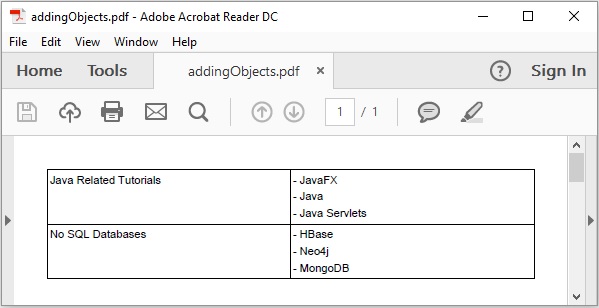
iText - Adding Image to a PDF
In this chapter, we will see how to add an image to a PDF document using the iText library.
Adding Image to a Pdf
You can create an empty PDF Document by instantiating the Document class. While instantiating this class, you need to pass a PdfDocument object as a parameter, to its constructor. To add image to the PDF, create an object of the image that is required to be added and add it using the add() method of the Document class.
Following are the steps to add an image to the PDF document.
Step 1: Creating a PdfWriter object
The PdfWriter class represents the DocWriter for a PDF. This class belongs to the package com.itextpdf.kernel.pdf. The constructor of this class accepts a string, representing the path of the file where the PDF is to be created.
Instantiate the PdfWriter class by passing a string value (representing the path where you need to create a PDF) to its constructor, as shown below.
// Creating a PdfWriter String dest = "C:/itextExamples/addingImage.pdf"; PdfWriter writer = new PdfWriter(dest);
When an object of this type is passed to a PdfDocument (class), every element added to this document will be written to the file specified.
Step 2: Creating a PdfDocument object
The PdfDocument class is the class that represents the PDF Document in iText. This class belongs to the package com.itextpdf.kernel.pdf. To instantiate this class (in writing mode), you need to pass an object of the class PdfWriter to its constructor.
Instantiate the PdfDocument class by passing the above created PdfWriter object to its constructor, as shown below.
// Creating a PdfDocument PdfDocument pdfDoc = new PdfDocument(writer);
Once a PdfDocument object is created, you can add various elements like page, font, file attachment, and event handler using the respective methods provided by its class.
Step 3: Creating the Document object
The Document class of the package com.itextpdf.layout is the root element while creating a self-sufficient PDF. One of the constructors of this class accepts an object of the class PdfDocument.
Instantiate the Document class by passing the object of the class PdfDocument created in the previous steps, as shown below.
// Creating a Document Document document = new Document(pdfDoc);
Step 4: Creating an Image object
To create the image object, first of all, create an ImageData object using the create() method of the ImageDataFactory class. As a parameter of this method, pass a string parameter representing the path of the image, as shown below.
// Creating an ImageData object String imageFile = "C:/itextExamples/javafxLogo.jpg"; ImageData data = ImageDataFactory.create(imageFile);
Now, instantiate the Image class of the com.itextpdf.layout.element package. While instantiating, pass the above created ImageData object as a parameter to its constructor, as shown below.
// Creating an Image object Image img = new Image(data);
Step 5: Adding image to the document
Add the image object created in the previous step using the add() method of the Document class, as shown below.
// Adding image to the document document.add(img);
Step 6: Closing the Document
Close the document using the close() method of the Document class, as shown below.
// Closing the document document.close();
Example
The following Java program demonstrates how to add an image to a PDF document using the iText library. It creates a PDF document with the name addingImage.pdf, adds an image to it, and saves it in the path C:/itextExamples/.
Save this code in a file with name AddingImage.java.
import com.itextpdf.io.image.ImageData;
import com.itextpdf.io.image.ImageDataFactory;
import com.itextpdf.kernel.pdf.PdfDocument;
import com.itextpdf.kernel.pdf.PdfWriter;
import com.itextpdf.layout.Document;
import com.itextpdf.layout.element.Image;
public class AddingImage {
public static void main(String args[]) throws Exception {
// Creating a PdfWriter
String dest = "C:/itextExamples/addingImage.pdf";
PdfWriter writer = new PdfWriter(dest);
// Creating a PdfDocument
PdfDocument pdf = new PdfDocument(writer);
// Creating a Document
Document document = new Document(pdf);
// Creating an ImageData object
String imFile = "C:/itextExamples/logo.jpg";
ImageData data = ImageDataFactory.create(imFile);
// Creating an Image object
Image image = new Image(data);
// Adding image to the document
document.add(image);
// Closing the document
document.close();
System.out.println("Image added");
}
}
Compile and execute the saved Java file from the Command prompt using the following commands −
javac AddingImage.java java AddingImage
Upon execution, the above program creates a PDF document displaying the following message.
Image added
If you verify the specified path, you can find the created PDF document, as shown below.
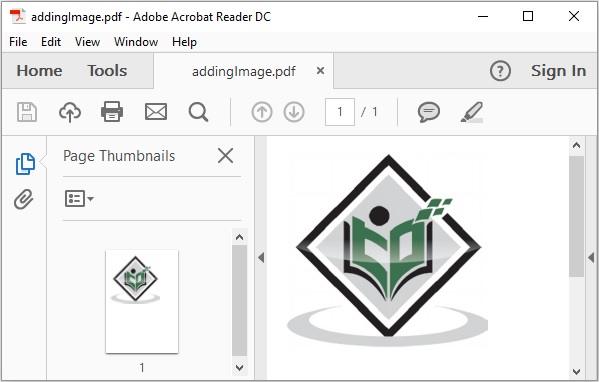
iText - Setting Position of the Image
In this chapter, we will see how to set the position of an image in a PDF document using the iText library.
Setting the Position of the Image
You can create an empty PDF Document by instantiating the Document class. While instantiating this class, you need to pass a PdfDocument object as a parameter to its constructor.
To add an image to the pdf, create and an object of the image that is required to be added and add it using the add() method of the Document class. You can insert the image in a desired position on the document using the method setFixedPosition() of the Image class.
Following are the steps to set the position of an image in the PDF document.
Step 1: Creating a PdfWriter object
The PdfWriter class represents the DocWriter for a PDF. This class belongs to the package com.itextpdf.kernel.pdf. The constructor of this class accepts a string, representing the path of the file where the PDF is to be created.
Instantiate the PdfWriter class by passing a string value (representing the path where you need to create a PDF) to its constructor, as shown below.
// Creating a PdfWriter String dest = "C:/itextExamples/positionOfImage.pdf"; PdfWriter writer = new PdfWriter(dest);
When an object of this type is passed to a PdfDocument (class), every element added to this document will be written to the file specified.
Step 2: Creating a PdfDocument object
The PdfDocument class is the class that represents the PDF Document in iText. This class belongs to the package com.itextpdf.kernel.pdf. To instantiate this class (in writing mode), you need to pass an object of the class PdfWriter to its constructor.
Instantiate the PdfDocument class by passing the above created PdfWriter object to its constructor, as shown below.
// Creating a PdfDocument PdfDocument pdfDoc = new PdfDocument(writer);
Once a PdfDocument object is created, you can add various elements like page, font, file attachment, and event handler using the respective methods provided by its class.
Step 3: Creating the Document object
The Document class of the package com.itextpdf.layout is the root element while creating a self-sufficient PDF. One of the constructors of this class accepts an object of the class PdfDocument.
Instantiate the Document class by passing the object of the class PdfDocument created in the previous steps, as shown below.
// Creating a Document Document document = new Document(pdfDoc);
Step 4: Creating an Image object
To create the image object, first of all, create an ImageData object using the create() method of the ImageDataFactory class. As a parameter of this method, pass a string parameter representing the path of the image, as shown below.
// Creating an ImageData object String imageFile = "C:/itextExamples/javafxLogo.jpg"; ImageData data = ImageDataFactory.create(imageFile);
Now, instantiate the Image class of the com.itextpdf.layout.element package. While instantiating, pass the ImageData object as a parameter to its constructor, as shown below.
// Creating an Image object Image img = new Image(data);
Step 5: Setting the position of the image
You can set the position of the image in a PDF document using the setFixedPosition() method of the Image. Set the position of the image to the coordinates (100, 250) on the document using this method, as shown below.
// Setting the position of the image to the center of the page image.setFixedPosition(100, 250);
Step 6: Adding image to the document
Now, add the image object, created in the previous step, using the add() method of the Document class, as shown below.
// Adding image to the document document.add(img);
Step 7: Closing the Document
Close the document using the close() method of the Document class, as shown below.
// Closing the document document.close();
Example
The following Java program demonstrates how to set an image at a desired position on a PDF document using the iText library. It creates a PDF document with the name positionOfImage.pdf, adds an image to it, sets it nearer to the center of the page, and saves it in the path C:/itextExamples/
Save this code in a file with the name SettingPosition.java.
import com.itextpdf.io.image.ImageData;
import com.itextpdf.io.image.ImageDataFactory;
import com.itextpdf.kernel.pdf.PdfDocument;
import com.itextpdf.kernel.pdf.PdfWriter;
import com.itextpdf.layout.Document;
import com.itextpdf.layout.element.Image;
public class SettingPosition {
public static void main(String args[]) throws Exception {
// Creating a PdfWriter
String dest = "C:/EXAMPLES/itextExamples/3images/positionOfImage.pdf";
PdfWriter writer = new PdfWriter(dest);
// Creating a PdfDocument
PdfDocument pdfDoc = new PdfDocument(writer);
// Creating a Document
Document document = new Document(pdfDoc);
// Creating an ImageData object
String imFile = "C:/EXAMPLES/itextExamples/3images/logo.jpg";
ImageData data = ImageDataFactory.create(imFile);
// Creating an Image object
Image image = new Image(data);
// Setting the position of the image to the center of the page
image.setFixedPosition(100, 250);
// Adding image to the document
document.add(image);
// Closing the document
document.close();
System.out.println("Image added");
}
}
Compile and execute the saved Java file from the command prompt using the following commands.
javac SettingPosition.java java SettingPosition
Upon execution, the above program creates a PDF document, displaying the following message.
Image added
If you verify the specified path, you can find the created PDF document as shown below.
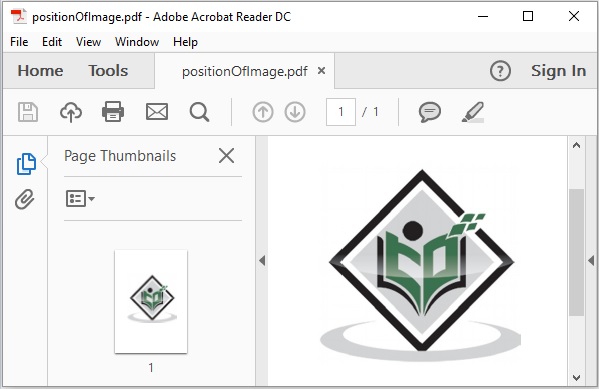
iText - Scaling an Image
In this chapter, we will see how to scale an image in a PDF document using the iText library.
Scaling an Image in a PDF
You can create an empty PDF Document by instantiating the Document class. While instantiating this class, you need to pass a PdfDocument object as a parameter to its constructor.
To add image to the PDF, create an object of the image that is required to be added and add it using the add() method of the Document class. You can scale an image using the setAutoScale() method.
Following are the steps to scale an image that exists on the PDF document.
Step 1: Creating a PdfWriter object
The PdfWriter class represents the DocWriter for a PDF. This class belongs to the package com.itextpdf.kernel.pdf. The constructor of this class accepts a string, representing the path of the file where the PDF is to be created.
Instantiate the PdfWriter class by passing a string value (representing the path where you need to create a PDF) to its constructor, as shown below.
// Creating a PdfWriter String dest = "C:/itextExamples/autoScale.pdf"; PdfWriter writer = new PdfWriter(dest);
When an object of this type is passed to a PdfDocument (class), every element added to this document will be written to the file specified.
Step 2: Creating a PdfDocument object
The PdfDocument class is the class that represents the PDF Document in iText. This class belongs to the package com.itextpdf.kernel.pdf. To instantiate this class (in writing mode), you need to pass an object of the class PdfWriter to its constructor.
Instantiate the PdfDocument class by passing the above created PdfWriter object to its constructor, as shown below.
// Creating a PdfDocument PdfDocument pdfDoc = new PdfDocument(writer);
Once a PdfDocument object is created, you can add various elements like page, font, file attachment, and event handler using the respective methods provided by its class.
Step 3: Creating the Document object
The Document class of the package com.itextpdf.layout is the root element while creating a self-sufficient PDF. One of the constructors of this class accepts an object of the class PdfDocument.
Instantiate the Document class by passing the object of the class PdfDocument created in the previous steps, as shown below.
// Creating a Document Document document = new Document(pdfDoc);
Step 4: Creating an Image object
To create an image object, first of all, create an ImageData object using the create() method of the ImageDataFactory class. As a parameter of this method, pass a string parameter representing the path of the image, as shown below.
// Creating an ImageData object String imageFile = "C:/itextExamples/javafxLogo.jpg"; ImageData data = ImageDataFactory.create(imageFile);
Now, instantiate the Image class of the com.itextpdf.layout.element package. While instantiating, pass the ImageData object as a parameter to its constructor, as shown below.
// Creating an Image object Image img = new Image(data);
Step 5: Scaling an image
You can scale an image using the setAutoScale() method.
// Setting the position of the image to the center of the page image.setFixedPosition(100, 250);
Step 6: Adding image to the document
Now, add the image object created in the previous step using the add() method of the Document class, as shown below.
// Adding image to the document document.add(img);
Step 7: Closing the Document
Close the document using the close() method of the Document class, as shown below.
// Closing the document document.close();
Example
The following Java program demonstrates how to scale an image with respective to the document size on a PDF document using the iText library. It creates a PDF document with the name autoScale.pdf, adds an image to it, scales it with respect to the page dimensions, saves it in the path C:/itextExamples/.
Save this code in a file with name SettingAutoScale.java.
import com.itextpdf.io.image.ImageData;
import com.itextpdf.io.image.ImageDataFactory;
import com.itextpdf.kernel.pdf.PdfDocument;
import com.itextpdf.kernel.pdf.PdfWriter;
import com.itextpdf.layout.Document;
import com.itextpdf.layout.element.Image;
public class SettingAutoScale {
public static void main(String args[]) throws Exception{
// Creating a PdfWriter
String dest = "C:/itextExamples/positionOfImage.pdf";
PdfWriter writer = new PdfWriter(dest);
// Creating a PdfDocument
PdfDocument pdfDoc = new PdfDocument(writer);
// Creating a Document
Document document = new Document(pdfDoc);
// Creating an ImageData object
String imFile = "C:/itextExamples/logo.jpg";
ImageData data = ImageDataFactory.create(imFile);
// Creating an Image object
Image image = new Image(data);
// Setting the position of the image to the center of the page
image.setFixedPosition(100,250);
// Adding image to the document
document.add(image);
// Closing the document
document.close();
System.out.println("Image Scaled");
}
}
Compile and execute the saved Java file from the command prompt using the following commands.
javac SettingAutoScale.java java SettingAutoScale
Upon execution, the above program creates a PDF document displaying the following message.
Image Scaled
If you verify the specified path, you can find the created PDF document as shown below.
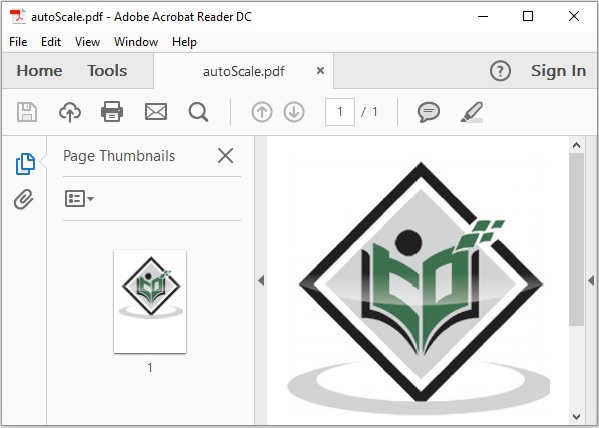
iText - Rotating an Image
In this chapter, we will see how to insert an image in a PDF document and how to rotate that image, using the functions available in the iText library.
Rotating an Image in a PDF
You can create an empty PDF Document by instantiating the Document class. While instantiating this class, you need to pass a PdfDocument object as a parameter to its constructor.
To add image to the PDF, create an object of the image that is required to be added and add it using the add() method of the Document class. You can rotate an image using the setRotationAngle() method.
Following are the steps to rotate an image in a PDF document.
Step 1: Creating a PdfWriter object
The PdfWriter class represents the DocWriter for a PDF. This class belongs to the package com.itextpdf.kernel.pdf. The constructor of this class accepts a string, representing the path of the file where the PDF is to be created.
Instantiate the PdfWriter class by passing a string value (representing the path where you need to create a PDF) to its constructor, as shown below.
// Creating a PdfWriter String dest = "C:/itextExamples/rotatingImage.pdf"; PdfWriter writer = new PdfWriter(dest);
When an object of this type is passed to a PdfDocument (class), every element added to this document will be written to the file specified.
Step 2: Creating a PdfDocument object
The PdfDocument class is the class that represents the PDF Document in iText. This class belongs to the package com.itextpdf.kernel.pdf. To instantiate this class (in writing mode), you need to pass an object of the class PdfWriter to its constructor.
Instantiate the PdfDocument class by passing the PdfWriter object to its constructor, as shown below.
// Creating a PdfDocument PdfDocument pdfDoc = new PdfDocument(writer);
Once a PdfDocument object is created, you can add various elements like page, font, file attachment, and event handler using the respective methods provided by its class.
Step 3: Creating the Document object
The Document class of the package com.itextpdf.layout is the root element while creating a self-sufficient PDF. One of the constructors of this class accepts an object of the class PdfDocument.
Instantiate the Document class by passing the object of the class PdfDocument created in the previous steps, as shown below.
// Creating a Document Document document = new Document(pdfDoc);
Step 4: Creating an Image object
To create an image object, first of all, create an ImageData object using the create()method of the ImageDataFactory class. As a parameter of this method, pass a string parameter representing the path of the image, as shown below.
// Creating an ImageData object String imageFile = "C:/itextExamples/javafxLogo.jpg"; ImageData data = ImageDataFactory.create(imageFile);
Now, instantiate the Image class of the com.itextpdf.layout.element package. While instantiating, pass the ImageData object, as a parameter to its constructor, as shown below.
// Creating an Image object Image img = new Image(data);
Step 5: rotating an image
You can rotate an image using the setRotationAngle() method. To this method, you need to pass an integer representing the rotation angle by which you want to rotate the image.
// Rotating the image image.setRotationAngle(45);
Step 6: Adding image to the document
Now, add the image object created in the previous step using the add() method of the Document class, as shown below.
// Adding image to the document document.add(img);
Step 7: Closing the Document
Close the document using the close() method of the Document class, as shown below.
// Closing the document document.close();
Example
The following Java program demonstrates how to rotate an image by a given angle on a PDF document using the iText library.
It creates a PDF document with the name rotatingImage.pdf, adds an image to it, rotates it, and saves it in the path C:/itextExamples/.
Save this code in a file with the name RotatingImage.java.
import com.itextpdf.io.image.ImageData;
import com.itextpdf.io.image.ImageDataFactory;
import com.itextpdf.kernel.pdf.PdfDocument;
import com.itextpdf.kernel.pdf.PdfWriter;
import com.itextpdf.layout.Document;
import com.itextpdf.layout.element.Image;
public class RotatingImage {
public static void main(String args[]) throws Exception {
// Creating a PdfWriter
String dest = "C:/itextExamples/rotatingImage.pdf";
PdfWriter writer = new PdfWriter(dest);
// Creating a PdfDocument
PdfDocument pdfDoc = new PdfDocument(writer);
// Creating a Document
Document document = new Document(pdfDoc);
// Creating an ImageData object
String imFile = "C:/itextExamples/logo.jpg";
ImageData data = ImageDataFactory.create(imFile);
// Creating an Image object
Image image = new Image(data);
// Rotating the image
image.setRotationAngle(45);
// Adding image to the document
document.add(image);
// Closing the document
document.close();
System.out.println("Image rotated");
}
}
Compile and execute the saved Java file from the Command prompt using the following commands −
javac RotatingImage.java java RotatingImage
Upon execution, the above program creates a PDF document displaying the following message.
Image Rotated
If you verify the specified path, you can find the created PDF document as shown below.
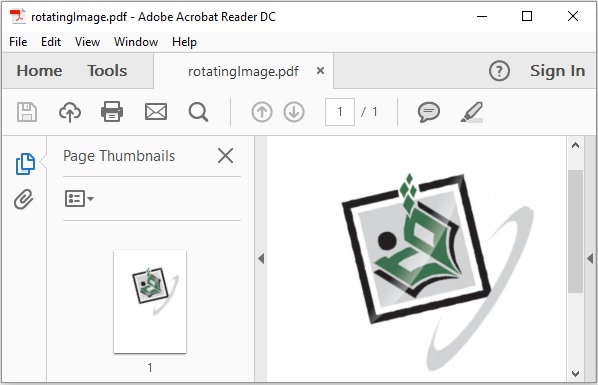
iText - Text Annotation
In this chapter, we will see how to add text annotation to a PDF document using iText library.
Creating a Text Annotation in a PDF
You can create an empty PDF Document by instantiating the Document class. While instantiating this class, you need to pass a PdfDocument object as a parameter to its constructor.
To use text annotation in your PDF document, you need to create an object of PdfTextAnnotation class and add this to the PdfPage.
Following are the steps to use text annotation in the PDF document.
Step 1: Creating a PdfWriter object
The PdfWriter class represents the DocWriter for a PDF. This class belongs to the package com.itextpdf.kernel.pdf. The constructor of this class accepts a string, representing the path of the file where the PDF is to be created.
Instantiate the PdfWriter class by passing a string value (representing the path where you need to create a PDF) to its constructor, as shown below.
// Creating a PdfWriter String dest = "C:/itextExamples/textAnnotation.pdf"; PdfWriter writer = new PdfWriter(dest);
When an object of this type is passed to a PdfDocument (class), every element added to this document will be written to the file specified.
Step 2: Creating a PdfDocument object
The PdfDocument class is the class that represents the PDF Document in iText. This class belongs to the package com.itextpdf.kernel.pdf. To instantiate this class (in writing mode), you need to pass an object of the class PdfWriter to its constructor.
Instantiate the PdfDocument class by passing the PdfWriter object to its constructor, as shown below.
// Creating a PdfDocument PdfDocument pdfDoc = new PdfDocument(writer);
Once a PdfDocument object is created, you can add various elements like page, font, file attachment, and event handler using the respective methods provided by its class.
Step 3: Creating the Document object
The Document class of the package com.itextpdf.layout is the root element while creating a self-sufficient PDF. One of the constructors of this class accepts an object of the class PdfDocument.
Instantiate the Document class by passing the object of the class PdfDocument created in the previous steps, as shown below.
// Creating a Document Document document = new Document(pdfDoc);
Step 4: Creating PdfAnnotation object
The PdfAnnotation class of the package com.itextpdf.kernel.pdf.annot represents the superclass of all the annotations.
Among its derived classes, PdfTextAnnotation class represents the text annotation. Create an object of this class as shown below.
// Creating PdfAnnotation Rectangle rect = new Rectangle(20, 800, 0, 0); PdfAnnotation ann = new PdfTextAnnotation(rect);
Step 5: Setting the color of the annotation
Set color to the annotation using the setColor() method of the PdfAnnotation class. To this method, pass the color object representing the color of the annotation as a parameter.
// Setting color to the annotation ann.setColor(Color.GREEN);
Step 6: Setting the title and contents of the annotation
Set the title and contents of the annotation using the setTitle() and setContents() methods of the PdfAnnotation class respectively, as shown below.
// Setting title to the annotation
ann.setTitle(new PdfString("Hello"));
// Setting contents of the annotation
ann.setContents("Hi welcome to Tutorialspoint.");
Step 7: Adding the annotation to a page
Create a new PdfPage class using the addNewPage() method of the PdfDocument class and add the above annotation using the addAnnotation() method of PdfPage class, as shown below.
// Creating a new page PdfPage page = pdf.addNewPage(); // Adding annotation to a page in a PDF page.addAnnotation(ann);
Step 8: Closing the Document
Close the document using the close() method of the Document class, as shown below.
// Closing the document document.close();
Example
The following Java program demonstrates how to add text annotation to a PDF document using the iText library. It creates a PDF document with the name textAnnotation.pdf, adds a text annotation to it, and saves it in the path C:/itextExamples/
Save this code in a file with the name TextAnnotation.java.
import com.itextpdf.kernel.color.Color;
import com.itextpdf.kernel.geom.Rectangle;
import com.itextpdf.kernel.pdf.PdfDocument;
import com.itextpdf.kernel.pdf.PdfPage;
import com.itextpdf.kernel.pdf.PdfString;
import com.itextpdf.kernel.pdf.PdfWriter;
import com.itextpdf.kernel.pdf.annot.PdfAnnotation;
import com.itextpdf.kernel.pdf.annot.PdfTextAnnotation;
import com.itextpdf.layout.Document;
public class TextAnnotation {
public static void main(String args[]) throws Exception {
// Creating a PdfWriter
String dest = "C:/itextExamples/textAnnotation.pdf";
PdfWriter writer = new PdfWriter(dest);
// Creating a PdfDocument
PdfDocument pdf = new PdfDocument(writer);
// Creating a Document
Document document = new Document(pdf);
// Creating PdfTextAnnotation object
Rectangle rect = new Rectangle(20, 800, 0, 0);
PdfAnnotation ann = new PdfTextAnnotation(rect);
// Setting color to the annotation
ann.setColor(Color.GREEN);
// Setting title to the annotation
ann.setTitle(new PdfString("Hello"));
// Setting contents of the annotation
ann.setContents("Hi welcome to Tutorialspoint.");
// Creating a new page
PdfPage page = pdf.addNewPage();
// Adding annotation to a page in a PDF
page.addAnnotation(ann);
// Closing the document
document.close();
System.out.println("Annotation added successfully");
}
}
Compile and execute the saved Java file from the command prompt using the following commands.
javac TextAnnotation.java java TextAnnotation
Upon execution, the above program creates a PDF document displaying the following message.
Annotation added successfully
If you verify the specified path, you can find the created PDF document, as shown below.
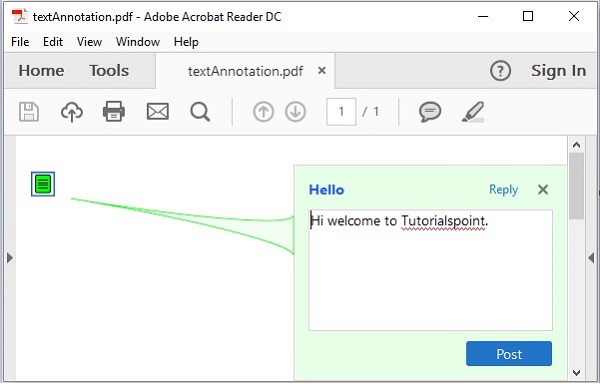
iText - Link Annotation
In this chapter, we will see how to add link annotation to a PDF document using iText library.
Creating a Link Annotation in a PDF
You can create an empty PDF Document by instantiating the Document class. While instantiating this class, you need to pass a PdfDocument object as a parameter to its constructor.
To use text annotation in your PDF document, you need to create an object of PdfTextAnnotation class and add this to the PdfPage.
Following are the steps to use text annotation in a PDF document.
Step 1 : Creating a PdfWriter object
The PdfWriter class represents the DocWriter for a PDF. This class belongs to the package com.itextpdf.kernel.pdf. The constructor of this class accepts a string, representing the path of the file where the PDF is to be created.
Instantiate the PdfWriter class by passing a string value (representing the path where you need to create a PDF) to its constructor, as shown below.
// Creating a PdfWriter String dest = "C:/itextExamples/linkAnnotation.pdf"; PdfWriter writer = new PdfWriter(dest);
When an object of this type is passed to a PdfDocument (class), every element added to this document will be written to the file specified.
Step 2: Creating a PdfDocument object
The PdfDocument class is the class that represents the PDF Document in iText. This class belongs to the package com.itextpdf.kernel.pdf. To instantiate this class (in writing mode), you need to pass an object of the class PdfWriter to its constructor.
Instantiate the PdfDocument class by passing the PdfWriter object to its constructor, as shown below.
// Creating a PdfDocument PdfDocument pdfDoc = new PdfDocument(writer);
Once a PdfDocument object is created, you can add various elements like page, font, file attachment, and event handler using the respective methods provided by its class.
Step 3: Creating the Document object
The Document class of the package com.itextpdf.layout is the root element while creating a self-sufficient PDF. One of the constructors of this class accepts an object of the class PdfDocument.
Instantiate the Document class by passing the object of the class PdfDocument created in the previous steps, as shown below.
// Creating a Document Document document = new Document(pdfDoc);
Step 4: Creating PdfAnnotation object
The PdfAnnotation class of the package com.itextpdf.kernel.pdf.annot represents the superclass of all the annotations.
Among its derived classes, PdfLinkAnnotation class represents the link annotation. Create an object of this class, as shown below.
// Creating a PdfLinkAnnotation object Rectangle rect = new Rectangle(0, 0); PdfLinkAnnotation annotation = new PdfLinkAnnotation(rect);
Step 5: Setting the action of the annotation
Set action to the annotation using the setAction() method of the PdfLinkAnnotation class, as shown below.
// Setting action of the annotation
PdfAction action = PdfAction.createURI("http: // www.tutorialspoint.com/");
annotation.setAction(action);
Step 6: Creating a link
Create a link by instantiating the Link class of the package com.itextpdf.layout.element, as shown below.
// Creating a link
Link link = new Link("Click here", annotation);
Step 7: Adding the link annotation to a paragraph
Create a new paragraph by instantiating the Paragraph class and add the link created in the previous step using the add() method of this class, as shown below.
// Creating a paragraph
Paragraph paragraph = new Paragraph("Hi welcome to Tutorialspoint ");
// Adding link to paragraph
paragraph.add(link.setUnderline());
Step 8: Adding paragraph to the document
Add the paragraph to the document using the add() method of the Document class, as shown below.
// Adding paragraph to document document.add(paragraph);
Step 9: Closing the Document
Close the document using the close() method of the Document class, as shown below.
// Closing the document document.close();
Example
The following Java program demonstrates how to add link annotation to a PDF document using the iText library.
It creates a PDF document with the name linkAnnotation.pdf, adds a link annotation to it, and saves it in the path C:/itextExamples/
Save this code in a file with the name LinkAnnotation.java.
import com.itextpdf.kernel.geom.Rectangle;
import com.itextpdf.kernel.pdf.PdfDocument;
import com.itextpdf.kernel.pdf.PdfWriter;
import com.itextpdf.kernel.pdf.action.PdfAction;
import com.itextpdf.kernel.pdf.annot.PdfLinkAnnotation;
import com.itextpdf.layout.Document;
import com.itextpdf.layout.element.Link;
import com.itextpdf.layout.element.Paragraph;
public class LinkAnnotation {
public static void main(String args[]) throws Exception {
// Creating a PdfWriter
String dest = "C:/itextExamples/linkAnnotation.pdf";
PdfWriter writer = new
PdfWriter(dest);
// Creating a PdfDocument
PdfDocument pdf = new PdfDocument(writer);
// Creating a Document
Document document = new Document(pdf);
// Creating a PdfLinkAnnotation object
Rectangle rect = new Rectangle(0, 0);
PdfLinkAnnotation annotation = new PdfLinkAnnotation(rect);
// Setting action of the annotation
PdfAction action = PdfAction.createURI("http:// www.tutorialspoint.com/");
annotation.setAction(action);
// Creating a link
Link link = new Link("Click here", annotation);
// Creating a paragraph
Paragraph paragraph = new Paragraph("Hi welcome to Tutorialspoint ");
// Adding link to paragraph
paragraph.add(link.setUnderline());
// Adding paragraph to document
document.add(paragraph);
// Closing the document
document.close();
System.out.println("Annotation added successfully");
}
}
Compile and execute the saved Java file from the Command prompt using the following commands −
javac LinkAnnotation.java java LinkAnnotation
Upon execution, the above program creates a PDF document displaying the following message.
Annotation added successfully
If you verify the specified path, you can find the created PDF document, as shown below.
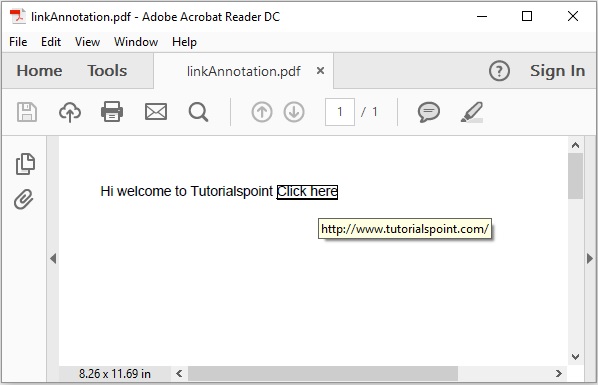
iText - Line Annotation
In this chapter, we will see how to add line annotation to a PDF document using iText library.
Creating a Line Annotation in a Pdf
You can create an empty PDF Document by instantiating the Document class. While instantiating this class, you need to pass a PdfDocument object as a parameter, to its constructor.
To use text annotation in your PDF document, you need to create an object of PdfTextAnnotation class and add this to the PdfPage.
Following are the steps to use text annotation in the PDF document.
Step 1: Creating a PdfWriter object
The PdfWriter class represents the DocWriter for a PDF. This class belongs to the package com.itextpdf.kernel.pdf. The constructor of this class accepts a string, representing the path of the file where the PDF is to be created.
Instantiate PdfWriter class by passing a string value representing the path where you need to create a PDF, to its constructor, as shown below.
// Creating a PdfWriter String dest = "C:/itextExamples/lineAnnotation.pdf"; PdfWriter writer = new PdfWriter(dest);
When an object of this type is passed to a PdfDocument (class), every element added to this document will be written to the file specified.
Step 2: Creating a PdfDocument object
The PdfDocument class is the class that represents the PDFDocument in iText. This class belongs to the package com.itextpdf.kernel.pdf. To instantiate this class (in writing mode), you need to pass an object of the class PdfWriter to its constructor.
Instantiate the PdfDocument class by passing the PdfWriter object to its constructor, as shown below.
// Creating a PdfDocument PdfDocument pdfDoc = new PdfDocument(writer);
Once a PdfDocument object is created, you can add various elements like page, font, file attachment, event handler using the respective methods provided by its class.
Step 3: Creating the Document object
The Document class of the package com.itextpdf.layout is the root element while creating a self-sufficient PDF. One of the constructors of this class accepts an object of the class PdfDocument.
Instantiate the Document class by passing the object of the class PdfDocument created in the previous steps, as shown below.
// Creating a Document Document document = new Document(pdfDoc);
Step 4: Creating PdfAnnotation object
The PdfAnnotation class of the package com.itextpdf.kernel.pdf.annot represents is the superclass of all the annotations.
Among its derived classes, PdfLineAnnotation class represents the line annotation. Create an object of this class as shown below.
// Creating PdfAnnotation Rectangle rect = new Rectangle(20, 800, 0, 0); PdfAnnotation annotation = new PdfLineAnnotation(rect);
Step 5: Setting the color of the annotation
Set color to the annotation using the setColor() method of the PdfAnnotation class. To this method, pass the color object representing the color of the annotation as a parameter.
// Setting color to the annotation annotation.setColor(Color.BLUE);
Step 6: Setting the title and contents of the annotation
Set the title and contents of the annotation using the setTitle() and setContents() methods of the PdfAnnotation class respectively, as shown below.
// Setting title to the PdfLineAnnotation
annotation.setTitle(new PdfString("iText"));
// Setting contents of the PdfLineAnnotation
annotation.setContents("Hi welcome to Tutorialspoint");
Step 7: Adding the annotation to a page
Create a new PdfPage class using the addNewPage() method of the PdfDocument class and add the above created annotation using the addAnnotation() method of PdfPage class, as shown below.
// Creating a new page PdfPage page = pdf.addNewPage(); // Adding annotation to a page in a PDF page.addAnnotation(annotation);
Step 8: Closing the Document
Close the document using the close() method of the Document class, as shown below.
// Closing the document document.close();
Example
The following Java program demonstrates how to add line annotation to a PDF document using the iText library. It creates a PDF document with the name lineAnnotation.pdf, adds a line annotation to it, and saves it in the path C:/itextExamples/.
Save this code in a file with name LineAnnotation.java.
import com.itextpdf.kernel.color.Color;
import com.itextpdf.kernel.geom.Rectangle;
import com.itextpdf.kernel.pdf.PdfDocument;
import com.itextpdf.kernel.pdf.PdfPage;
import com.itextpdf.kernel.pdf.PdfString;
import com.itextpdf.kernel.pdf.PdfWriter;
import com.itextpdf.kernel.pdf.annot.PdfAnnotation;
import com.itextpdf.kernel.pdf.annot.PdfLineAnnotation;
import com.itextpdf.layout.Document;
public class LineAnnotation {
public static void main(String args[]) throws Exception {
// Creating a PdfWriter
String dest = "C:/itextExamples/lineAnnotations.pdf";
PdfWriter writer = new PdfWriter(dest);
// Creating a PdfDocument
PdfDocument pdf = new PdfDocument(writer);
// Creating a Document
Document document = new Document(pdf);
// Creating a PdfPage
PdfPage page = pdf.addNewPage();
// creating PdfLineAnnotation object
Rectangle rect = new Rectangle(0, 0);
float[] floatArray = new float[]{
20, 790, page.getPageSize().getWidth() - 20, 790
};
PdfAnnotation annotation = new PdfLineAnnotation(rect, floatArray);
// Setting color of the PdfLineAnnotation
annotation.setColor(Color.BLUE);
// Setting title to the PdfLineAnnotation
annotation.setTitle(new PdfString("iText"));
// Setting contents of the PdfLineAnnotation
annotation.setContents("Hi welcome to Tutorialspoint");
// Adding annotation to the page
page.addAnnotation(annotation);
// Closing the document
document.close();
System.out.println("Annotation added successfully");
}
}
Compile and execute the saved Java file from the command prompt using the following commands −
javac LineAnnotation.java java LineAnnotation
Upon execution, the above program creates a PDF document displaying the following message.
Annotation added successfully
If you verify the specified path, you can find the created PDF document as shown below.
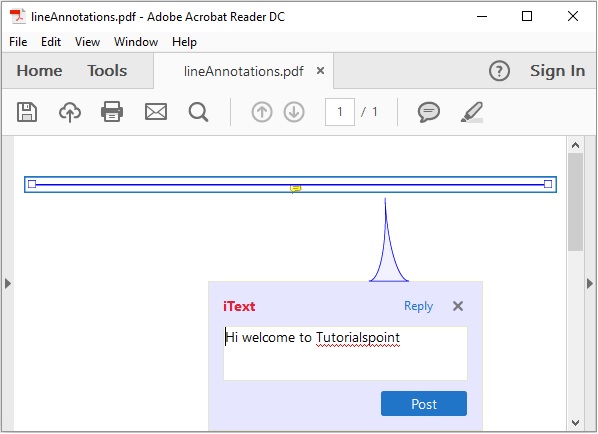
iText - Markup Annotation
In this chapter, we will see how to add text markup annotation to a PDF document using iText library.
Creating a Markup Annotation in a PDF
You can create an empty PDF Document by instantiating the Document class. While instantiating this class, you need to pass a PdfDocument object as a parameter to its constructor. To use text annotation in your PDF document, you need to create an object of PdfTextAnnotation class and add this to the PdfPage.
Following are the steps to use text annotation in the PDF document.
Step 1: Creating a PdfWriter object
The PdfWriter class represents the DocWriter for a PDF. This class belongs to the package com.itextpdf.kernel.pdf. The constructor of this class accepts a string, representing the path of the file where the PDF is to be created.
Instantiate the PdfWriter class by passing a string value (representing the path where you need to create a PDF) to its constructor, as shown below.
// Creating a PdfWriter String dest = "C:/itextExamples/markupAnnotation.pdf"; PdfWriter writer = new PdfWriter(dest);
When an object of this type is passed to a PdfDocument (class), every element added to this document will be written to the file specified.
Step 2: Creating a PdfDocument object
The PdfDocument class is the class that represents the PDF Document in iText. This class belongs to the package com.itextpdf.kernel.pdf. To instantiate this class (in writing mode), you need to pass an object of the class PdfWriter to its constructor.
Instantiate the PdfDocument class by passing the PdfWriter object to its constructor, as shown below.
// Creating a PdfDocument PdfDocument pdfDoc = new PdfDocument(writer);
Once a PdfDocument object is created, you can add various elements like page, font, file attachment, and event handler using the respective methods provided by its class.
Step 3: Creating the Document object
The Document class of the package com.itextpdf.layout is the root element while creating a self-sufficient PDF. One of the constructors of this class accepts an object of the class PdfDocument.
Instantiate the Document class by passing the object of the class PdfDocument created in the previous steps, as shown below.
// Creating a Document Document document = new Document(pdfDoc);
Step 4: Creating PdfAnnotation object
The PdfAnnotation class of the package com.itextpdf.kernel.pdf.annot represents the superclass of all the annotations.
Among its derived classes, PdfTextMarkupAnnotation class represents the text markup annotation. Create an object of this class as shown below.
// Creating a PdfTextMarkupAnnotation object
Rectangle rect = new Rectangle(105, 790, 64, 10);
float[] floatArray = new float[]{169, 790, 105, 790, 169, 800, 105, 800};
PdfAnnotation annotation = PdfTextMarkupAnnotation.createHighLight(rect,floatArray);
Step 5: Setting the color of the annotation
Set color to the annotation using the setColor() method of the PdfAnnotation class. To this method, pass the color object representing the color of the annotation as a parameter.
// Setting color to the annotation annotation.setColor(Color.YELLOW);
Step 6: Setting the title and contents of the annotation
Set the title and contents of the annotation using the setTitle() and setContents() methods of the PdfAnnotation class respectively.
// Setting title to the annotation
annotation.setTitle(new PdfString("Hello!"));
// Setting contents to the annotation
annotation.setContents(new PdfString("Hi welcome to Tutorialspoint"));
Step 7: Adding the annotation to a page
Create a new PdfPage class using the addNewPage() method of the PdfDocument class and add the above created annotation using the addAnnotation() method of PdfPage class, as shown below.
// Creating a new Pdfpage PdfPage pdfPage = pdfDoc.addNewPage(); // Adding annotation to a page in a PDF pdfPage.addAnnotation(annotation);
Step 8: Closing the Document
Close the document using the close() method of the Document class, as shown below.
// Closing the document document.close();
Example
The following Java program demonstrates how to add text markup annotation to a PDF document using the iText library. It creates a PDF document with the name markupAnnotation.pdf, adds a text markup annotation to it, and saves it in the path C:/itextExamples/
Save this code in a file with the name MarkupAnnotation.java.
import com.itextpdf.kernel.color.Color;
import com.itextpdf.kernel.geom.Rectangle;
import com.itextpdf.kernel.pdf.PdfDocument;
import com.itextpdf.kernel.pdf.PdfPage;
import com.itextpdf.kernel.pdf.PdfString;
import com.itextpdf.kernel.pdf.PdfWriter;
import com.itextpdf.kernel.pdf.annot.PdfAnnotation;
import com.itextpdf.kernel.pdf.annot.PdfTextMarkupAnnotation;
import com.itextpdf.layout.Document;
public class MarkupAnnotation {
public static void main(String args[]) throws Exception {
// Creating a PdfDocument object
String file = "C:/itextExamples/markupAnnotation.pdf";
PdfDocument pdfDoc = new PdfDocument(new PdfWriter(file));
// Creating a Document object
Document doc = new Document(pdfDoc);
// Creating a PdfTextMarkupAnnotation object
Rectangle rect = new Rectangle(105, 790, 64, 10);
float[] floatArray = new float[]{169, 790, 105, 790, 169, 800, 105, 800};
PdfAnnotation annotation =
PdfTextMarkupAnnotation.createHighLight(rect,floatArray);
// Setting color to the annotation
annotation.setColor(Color.YELLOW);
// Setting title to the annotation
annotation.setTitle(new PdfString("Hello!"));
// Setting contents to the annotation
annotation.setContents(new PdfString("Hi welcome to Tutorialspoint"));
// Creating a new Pdfpage
PdfPage pdfPage = pdfDoc.addNewPage();
// Adding annotation to a page in a PDF
pdfPage.addAnnotation(annotation);
// Closing the document
doc.close();
System.out.println("Annotation added successfully");
}
}
Compile and execute the saved Java file from the Command prompt using the following commands −
javac MarkupAnnotation.java java MarkupAnnotation
Upon execution, the above program creates a PDF document displaying the following message.
Annotation added successfully
If you verify the specified path, you can find the created PDF document as shown below.
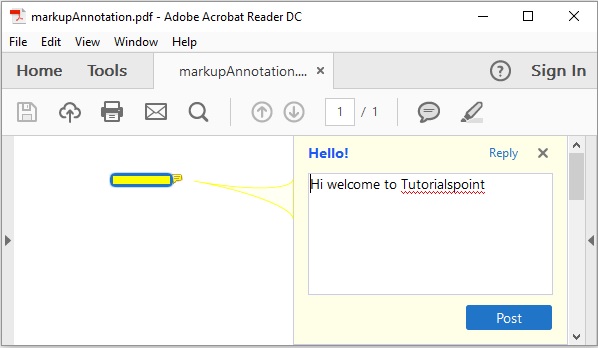
iText - Circle Annotation
In this chapter, we will see how to add circle annotation to a PDF document using iText library.
Creating a Circle Annotation in a PDF
You can create an empty PDF Document by instantiating the Document class. While instantiating this class, you need to pass a PdfDocument object as a parameter to its constructor.
To use text annotation in your PDF document, you need to create an object of PdfTextAnnotation class and add this to the Pdfpage.
Following are the steps to use text annotation in the PDF document.
Step 1: Creating a PdfWriter object
The PdfWriter class represents the DocWriter for a PDF. This class belongs to the package com.itextpdf.kernel.pdf. The constructor of this class accepts a string, representing the path of the file where the PDF is to be created.
Instantiate the PdfWriter class by passing a string value (representing the path where you need to create a PDF) to its constructor, as shown below.
// Creating a PdfWriter String dest = "C:/itextExamples/circleAnnotation.pdf"; PdfWriter writer = new PdfWriter(dest);
When an object of this type is passed to a PdfDocument (class), every element added to this document will be written to the file specified.
Step 2: Creating a PdfDocument object
The PdfDocument class is the class that represents the PDF Document in iText. This class belongs to the package com.itextpdf.kernel.pdf. To instantiate this class (in writing mode), you need to pass an object of the class PdfWriter to its constructor.
Instantiate the PdfDocument class by passing the PdfWriter object to its constructor, as shown below.
// Creating a PdfDocument PdfDocument pdfDoc = new PdfDocument(writer);
Once a PdfDocument object is created, you can add various elements like page, font, file attachment, and event handler using the respective methods provided by its class.
Step 3: Creating the Document object
The Document class of the package com.itextpdf.layout is the root element while creating a self-sufficient PDF. One of the constructors of this class accepts an object of the class PdfDocument.
Instantiate the Document class by passing the object of the class PdfDocument created in the previous steps, as shown below.
// Creating a Document Document document = new Document(pdfDoc);
Step 4: Creating PdfAnnotation object
The PdfAnnotation class of the package com.itextpdf.kernel.pdf.annot represents the superclass of all the annotations.
Among its derived classes, PdfCircleAnnotation class represents the circle annotation. Create an object of this class as shown below.
// Creating a PdfCircleAnnotation object Rectangle rect = new Rectangle(150, 770, 50, 50); PdfAnnotation annotation = new PdfCircleAnnotation(rect);
Step 5: Setting the color of the annotation
Set color to the annotation using the setColor() method of the PdfAnnotation class. To this method, pass the color object representing the color of the annotation as a parameter.
// Setting color to the annotation annotation.setColor(Color.YELLOW);
Step 6: Setting the title and contents of the annotation
Set the title and contents of the annotation using the setTitle() and setContents() methods of the PdfAnnotation class respectively.
// Setting title to the annotation
annotation.setTitle(new PdfString("circle annotation"));
// Setting contents of the annotation
annotation.setContents(new PdfString("Hi welcome to Tutorialspoint"));
Step 7: Adding the annotation to a page
Create a new PdfPage class using the addNewPage() method of the PdfDocument class and add the above created annotation using the addAnnotation() method of PdfPage class, as shown below.
// Creating a new page PdfPage page = pdf.addNewPage(); // Adding annotation to a page in a PDF page.addAnnotation(ann);
Step 8: Closing the Document
Close the document using the close() method of the Document class, as shown below.
// Closing the document document.close();
Example
The following Java program demonstrates how to add circle annotation to a PDF document using the iText library. It creates a PDF document with the name circleAnnotation.pdf, adds a circle annotation to it, and saves it in the path C:/itextExamples/
Save this code in a file with the name PdfCircleAnnotation.java.
import com.itextpdf.kernel.color.Color;
import com.itextpdf.kernel.geom.Rectangle;
import com.itextpdf.kernel.pdf.PdfDocument;
import com.itextpdf.kernel.pdf.PdfPage;
import com.itextpdf.kernel.pdf.PdfString;
import com.itextpdf.kernel.pdf.PdfWriter;
import com.itextpdf.kernel.pdf.annot.PdfAnnotation;
import com.itextpdf.kernel.pdf.annot.PdfCircleAnnotation;
import com.itextpdf.layout.Document;
public class CircleAnnotation {
public static void main(String args[]) throws Exception {
// Creating a PdfDocument object
String file = "C:/itextExamples// circleAnnotation.pdf";
PdfDocument pdf = new PdfDocument(new PdfWriter(file));
// Creating a Document object
Document doc = new Document(pdf);
// Creating a PdfCircleAnnotation object
Rectangle rect = new Rectangle(150, 770, 50, 50);
PdfAnnotation annotation = new PdfCircleAnnotation(rect);
// Setting color to the annotation
annotation.setColor(Color.YELLOW);
// Setting title to the annotation
annotation.setTitle(new PdfString("circle annotation"));
// Setting contents of the annotation
annotation.setContents(new PdfString("Hi welcome to Tutorialspoint"));
// Creating a new page
PdfPage page = pdf.addNewPage();
// Adding annotation to a page in a PDF
page.addAnnotation(annotation);
// Closing the document
doc.close();
System.out.println("Annotation added successfully");
}
}
Compile and execute the saved Java file from the Command prompt using the following commands −
javac PdfCircleAnnotation.java java PdfCircleAnnotation
Upon execution, the above program creates a PDF document displaying the following message.
Annotation added successfully
If you verify the specified path, you can find the created PDF document, as shown below.
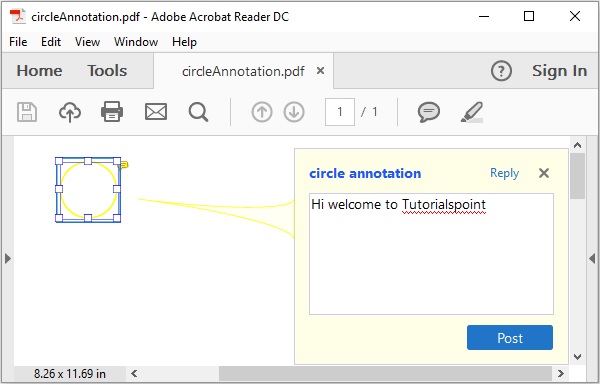
iText - Drawing an Arc
In this chapter, we will see how to draw an arc on a PDF document using iText library.
Drawing an Arc on a PDF
You can create an empty PDF Document by instantiating the Document class. While instantiating this class, you need to pass a PdfDocument object as a parameter to its constructor.
To draw an arc on a PdfDocument, instantiate the PdfCanvas class of the package com.itextpdf.kernel.pdf.canvas and create an arc using the arc() method of this class.
Following are the steps to draw an arc on a PDF document.
Step 1: Creating a PdfWriter object
The PdfWriter class represents the DocWriter for a PDF. This class belongs to the package com.itextpdf.kernel.pdf. The constructor of this class accepts a string, representing the path of the file where the PDF is to be created.
Instantiate the PdfWriter class by passing a string value (representing the path where you need to create a PDF) to its constructor, as shown below.
// Creating a PdfWriter String dest = "C:/itextExamples/drawingArc.pdf"; PdfWriter writer = new PdfWriter(dest);
When the object of this type is passed to a PdfDocument (class), every element added to this document will be written to the file specified.
Step 2: Creating a PdfDocument object
The PdfDocument class is the class that represents the PDF Document in iText. This class belongs to the package com.itextpdf.kernel.pdf. To instantiate this class (in writing mode), you need to pass an object of the class PdfWriter to its constructor.
Instantiate the PdfDocument class by passing the PdfWriter object to its constructor, as shown below.
// Creating a PdfDocument PdfDocument pdfDoc = new PdfDocument(writer);
Once a PdfDocument object is created, you can add various elements like page, font, file attachment, and event handler using the respective methods provided by its class.
Step 3: Creating the Document object
The Document class of the package com.itextpdf.layout is the root element while creating a self-sufficient PDF. One of the constructors of this class accepts an object of the class PdfDocument.
Instantiate the Document class by passing the object of the class PdfDocument created in the previous steps as shown below.
// Creating a Document Document document = new Document(pdfDoc);
Step 4: Creating a PdfCanvas object
Create a new PdfPage class using the addNewPage() method of the PdfDocument class.
Instantiate the PdfCanvas object of the package com.itextpdf.kernel.pdf.canvas by passing the above created PdfPage object to the constructor of this class, as shown below.
// Creating a new page PdfPage pdfPage = pdfDoc.addNewPage(); // Creating a PdfCanvas object PdfCanvas canvas = new PdfCanvas(pdfPage);
Step 5: Drawing the arc
Draw the arc using the arc() method of the Canvas class and fill it using the fill() method, as shown below.
// Drawing an arc canvas.arc(50, 50, 300, 545, 0, 360); // Filling the arc canvas.fill();
Step 6: Closing the Document
Close the document using the close() method of the Document class, as shown below.
// Closing the document document.close();
Example
The following Java program demonstrates how to draw an arc in a PDF document using the iText library.
It creates a PDF document with the name drawingArc.pdf, draws an arc in it, and saves it in the path C:/itextExamples/
Save this code in a file with the name DrawingArc.java.
import com.itextpdf.kernel.color.Color;
import com.itextpdf.kernel.pdf.PdfDocument;
import com.itextpdf.kernel.pdf.PdfPage;
import com.itextpdf.kernel.pdf.PdfWriter;
import com.itextpdf.kernel.pdf.canvas.PdfCanvas;
import com.itextpdf.layout.Document;
public class DrawingArc {
public static void main(String args[]) throws Exception {
// Creating a PdfWriter
String dest = "C:/itextExamples/drawingArc.pdf";
PdfWriter writer = new PdfWriter(dest);
// Creating a PdfDocument object
PdfDocument pdfDoc = new PdfDocument(writer);
// Creating a Document object
Document doc = new Document(pdfDoc);
// Creating a new page
PdfPage pdfPage = pdfDoc.addNewPage();
// Creating a PdfCanvas object
PdfCanvas canvas = new PdfCanvas(pdfPage);
// Drawing an arc
canvas.arc(50, 50, 300, 545, 0, 360);
// Filling the arc
canvas.fill();
// Closing the document
doc.close();
System.out.println("Object drawn on pdf successfully");
}
}
Compile and execute the saved Java file from the Command prompt using the following commands −
javac DrawingArc.java java DrawingArc
Upon execution, the above program creates a PDF document, displaying the following message.
Object drawn on pdf successfully
If you verify the specified path, you can find the created PDF document, as shown below.
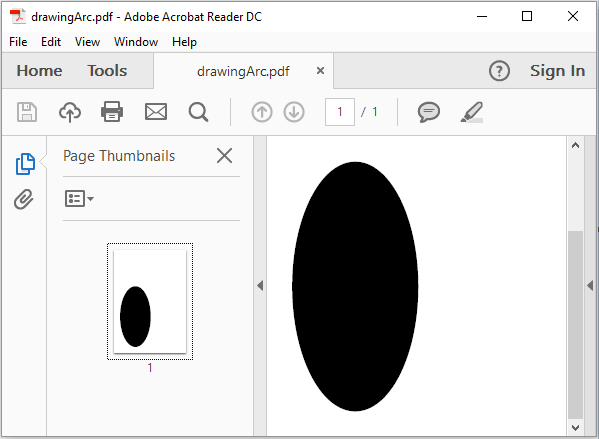
iText - Drawing a Line
In this chapter, we will see how to draw a line on a PDF document using iText library.
Drawing a Line on a PDF
You can create an empty PDF Document by instantiating the Document class. While instantiating this class, you need to pass a PdfDocument object as a parameter, to its constructor.
To draw a line on a PdfDocument Instantiate the PdfCanvas class of the package com.itextpdf.kernel.pdf.canvas and create a line using the moveTo() and lineTO() methods of this class.
Following are the steps to draw a line on the pdf document.
Step 1: Creating a PdfWriter object
The PdfWriter class represents the DocWriter for a PDF. This class belongs to the package com.itextpdf.kernel.pdf. The constructor of this class accepts a string, representing the path of the file where the PDF is to be created.
Instantiate the PdfWriter class by passing a string value (representing the path where you need to create a PDF) to its constructor, as shown below.
// Creating a PdfWriter String dest = "C:/itextExamples/drawingLine.pdf"; PdfWriter writer = new PdfWriter(dest);
When an object of this type is passed to a PdfDocument (class), every element added to this document will be written to the file specified.
Step 2: Creating a PdfDocument object
The PdfDocument class is the class that represents the PDF Document in iText. This class belongs to the package com.itextpdf.kernel.pdf. To instantiate this class (in writing mode), you need to pass an object of the class PdfWriter to its constructor.
Instantiate the PdfDocument class by passing above created PdfWriter object to its constructor, as shown below.
// Creating a PdfDocument PdfDocument pdfDoc = new PdfDocument(writer);
Once a PdfDocument object is created, you can add various elements like page, font, file attachment, and event handler using the respective methods provided by its class.
Step 3: Creating the Document object
The Document class of the package com.itextpdf.layout is the root element while creating a self-sufficient PDF. One of the constructors of this class accepts an object of the class PdfDocument.
Instantiate the Document class by passing the object of the class PdfDocument created in the previous steps as shown below.
// Creating a Document Document document = new Document(pdfDoc);
Step 4: Creating a PdfCanvas object
Create a new PdfPage class using the addNewPage() method of the PdfDocument class.
Instantiate the PdfCanvas object of the package com.itextpdf.kernel.pdf.canvas by passing the above created PdfPage object to the constructor of this class, as shown below.
// Creating a new page PdfPage pdfPage = pdfDoc.addNewPage(); // Creating a PdfCanvas object PdfCanvas canvas = new PdfCanvas(pdfPage);
Step 5: Drawing the line
Set the initial point of the line using the moveTO() method of the Canvas class, as shown below.
// Initial point of the line canvas.moveTo(100, 300);
Now, draw a line from this point to another point using the lineTo() method, as shown below.
// Drawing the line canvas.lineTo(500, 300);
Step 6: Closing the Document
Close the document using the close() method of the Document class, as shown below.
// Closing the document document.close();
Example
The following Java program demonstrates how to draw a line in a PDF document using the iText library. It creates a PDF document with the name drawingLine.pdf, draws an arc in it, and saves it in the path C:/itextExamples/
Save this code in a file with name DrawingLine.java.
import com.itextpdf.kernel.pdf.PdfDocument;
import com.itextpdf.kernel.pdf.PdfPage;
import com.itextpdf.kernel.pdf.PdfWriter;
import com.itextpdf.kernel.pdf.canvas.PdfCanvas;
import com.itextpdf.layout.Document;
public class DrawingLine {
public static void main(String args[]) throws Exception {
// Creating a PdfWriter
String dest = "C:/itextExamples/drawingLine.pdf";
PdfWriter writer = new PdfWriter(dest);
// Creating a PdfDocument object
PdfDocument pdfDoc = new PdfDocument(writer);
// Creating a Document object
Document doc = new Document(pdfDoc);
// Creating a new page
PdfPage pdfPage = pdfDoc.addNewPage();
// Creating a PdfCanvas object
PdfCanvas canvas = new PdfCanvas(pdfPage);
// Initial point of the line
canvas.moveTo(100, 300);
// Drawing the line
canvas.lineTo(500, 300);
// Closing the path stroke
canvas.closePathStroke();
// Closing the document
doc.close();
System.out.println("Object drawn on pdf successfully");
}
}
Compile and execute the saved Java file from the Command prompt using the following commands −
javac DrawingLine.java java DrawingLine
Upon execution, the above program creates a PDF document, displaying the following message.
Object drawn on pdf successfully
If you verify the specified path, you can find the created PDF document, as shown below.
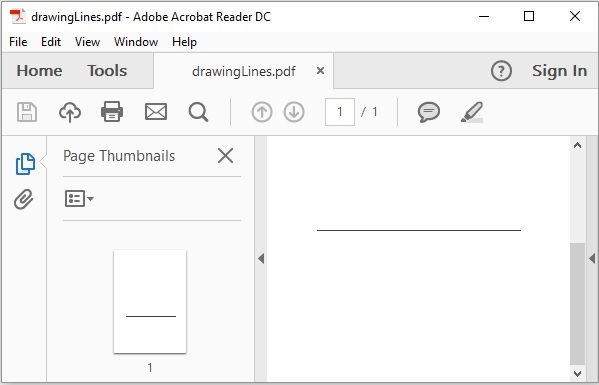
iText - Drawing a Circle
In this chapter, we will see how to draw a circle on a PDF document using iText library.
Drawing a Circle on a Pdf
You can create an empty PDF Document by instantiating the Document class. While instantiating this class, you need to pass a PdfDocument object as a parameter to its constructor.
To draw a circle on a PdfDocument, instantiate the PdfCanvas class of the package com.itextpdf.kernel.pdf.canvas and invoke the circle() method of this class.
Following are the steps to draw a circle on a PDF document.
Step 1: Creating a PdfWriter object
The PdfWriter class represents the DocWriter for a PDF. This class belongs to the package com.itextpdf.kernel.pdf. The constructor of this class accepts a string, representing the path of the file where the PDF is to be created.
Instantiate the PdfWriter class by passing a string value (representing the path where you need to create a PDF) to its constructor, as shown below.
// Creating a PdfWriter String dest = "C:/itextExamples/drawingCircle.pdf"; PdfWriter writer = new PdfWriter(dest);
When an object of this type is passed to a PdfDocument (class), every element added to this document will be written to the file specified.
Step 2: Creating a PdfDocument object
The PdfDocument class is the class that represents the PDF Document in iText. This class belongs to the package com.itextpdf.kernel.pdf. To instantiate this class (in writing mode), you need to pass an object of the class PdfWriter to its constructor.
Instantiate the PdfDocument class by passing PdfWriter object to its constructor, as shown below.
// Creating a PdfDocument PdfDocument pdfDoc = new PdfDocument(writer);
Once a PdfDocument object is created, you can add various elements like page, font, file attachment, and event handler using the respective methods provided by its class.
Step 3: Creating the Document object
The Document class of the package com.itextpdf.layout is the root element while creating a self-sufficient PDF. One of the constructors of this class accepts an object of the class PdfDocument.
Instantiate the Document class by passing the object of the class PdfDocument created in the previous steps, as shown below.
// Creating a Document Document document = new Document(pdfDoc);
Step 4: Creating a PdfCanvas object
Create a new PdfPage class using the addNewPage() method of the PdfDocument class. Instantiate the PdfCanvas object of the package com.itextpdf.kernel.pdf.canvas by passing the PdfPage object to the constructor of this class, as shown below.
// Creating a new page PdfPage pdfPage = pdfDoc.addNewPage(); // Creating a PdfCanvas object PdfCanvas canvas = new PdfCanvas(pdfPage);
Step 5 Setting the color
Set the color of the circle using the setColor() method of the Canvas class, as shown below.
// Setting color to the circle Color color = Color.GREEN; canvas.setColor(color, true);
Step 6: Drawing the Circle
Draw a circle by invoking the circle() method of the Canvas, as shown below.
// creating a circle canvas.circle(300, 400, 200);
Step 7: Closing the Document
Close the document using the close() method of the Document class, as shown below.
// Closing the document document.close();
Example
The following Java program demonstrates how to draw a circle on a pdf document using the iText library. It creates a PDF document with the name drawingCircle.pdf, draws a circle in it, and saves it in the path C:/itextExamples/
Save this code in a file with the name DrawingCircle.java.
import com.itextpdf.kernel.color.Color;
import com.itextpdf.kernel.pdf.PdfDocument;
import com.itextpdf.kernel.pdf.PdfPage;
import com.itextpdf.kernel.pdf.PdfWriter;
import com.itextpdf.kernel.pdf.canvas.PdfCanvas;
import com.itextpdf.layout.Document;
public class DrawingCircle {
public static void main(String args[]) throws Exception {
// Creating a PdfWriter
String dest = "C:/itextExamples/drawingCircle.pdf";
PdfWriter writer = new PdfWriter(dest);
// Creating a PdfDocument object
PdfDocument pdfDoc = new PdfDocument(writer);
// Creating a Document object
Document doc = new Document(pdfDoc);
// Creating a new page
PdfPage pdfPage = pdfDoc.addNewPage();
// Creating a PdfCanvas object
PdfCanvas canvas = new PdfCanvas(pdfPage);
// Setting color to the circle
Color color = Color.GREEN;
canvas.setColor(color, true);
// creating a circle
canvas.circle(300, 400, 200);
// Filling the circle
canvas.fill();
// Closing the document
doc.close();
System.out.println("Object drawn on pdf successfully");
}
}
Compile and execute the saved Java file from the Command prompt using the following commands.
javac DrawingCircle.java java DrawingCircle
Upon execution, the above program creates a PDF document displaying the following message.
Object drawn on pdf successfully
If you verify the specified path, you can find the created PDF document, as shown below.
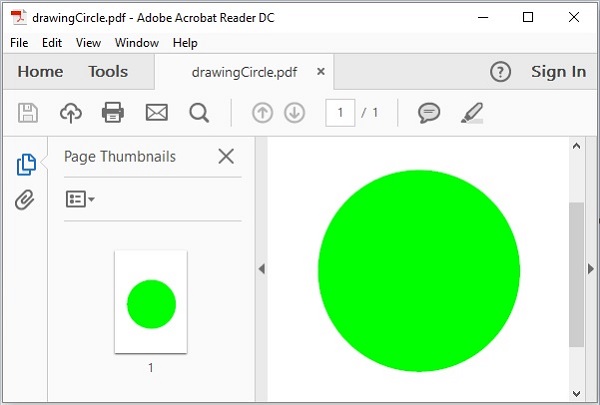
iText - Setting Font
In this chapter, we will see how to set color and font to text in a PDF document using the iText library.
Setting Font of the Text in a PDF
You can create an empty PDF Document by instantiating the Document class. While instantiating this class, you need to pass a PdfDocument object as a parameter to its constructor.
To add a paragraph to the document, you need to instantiate the Paragraph class and add this object to the document using the add() method. You can set color and font to the text using the methods setFontColor() and setFont() respectively.
Following are the steps to set color and font to text in a pdf document.
Step 1: Creating a PdfWriter object
The PdfWriter class represents the DocWriter for a PDF. This class belongs to the package com.itextpdf.kernel.pdf. The constructor of this class accepts a string, representing the path of the file where the PDF is to be created.
Instantiate the PdfWriter class by passing a string value (representing the path where you need to create a PDF) to its constructor, as shown below.
// Creating a PdfWriter String dest = "C:/itextExamples/fonts.pdf"; PdfWriter writer = new PdfWriter(dest);
When an object of this type is passed to a PdfDocument (class), every element added to this document will be written to the file specified.
Step 2: Creating a PdfDocument
The PdfDocument class is the class that represents the PDF Document in iText. This class belongs to the package com.itextpdf.kernel.pdf. To instantiate this class (in writing mode), you need to pass an object of the class PdfWriter to its constructor.
Instantiate the PdfDocument class by passing the PdfWriter object to its constructor, as shown below.
// Creating a PdfDocument PdfDocument pdfDoc = new PdfDocument(writer);
Once a PdfDocument object is created, you can add various elements like page, font, file attachment, and event handler using the respective methods provided by its class.
Step 3: Creating the Document class
The Document class of the package com.itextpdf.layout is the root element while creating a self-sufficient PDF. One of the constructors of this class accepts an object of the class PdfDocument.
Instantiate the Document class by passing the object of the class PdfDocument created in the previous steps, as shown below.
// Creating a Document Document document = new Document(pdfDoc);
Step 4: Creating Text
Create the text by instantiating the Text class of the package com.itextpdf.layout.element as shown below.
// Creating text object
Text text = new Text("Tutorialspoint");
Step 5: Setting the font and color to the text
Create the PdfFont object using the createFont() method of the class PdfFontFactory of the package com.itextpdf.kernel.font as shown below
// Setting font of the text PdfFont font = PdfFontFactory.createFont(FontConstants.HELVETICA_BOLD);
Now, set font to the text using the setFont() method of the Text class to this method. Pass the PdfFont object as a parameter, as shown below.
text1.setFont(font);
To set the color to the text invoke the setFontColor() method of the Text class, as shown below.
// Setting font color text.setFontColor(Color.GREEN);
Step 6: Adding text to the paragraph
Create a Paragraph class object and add the above created text using its add() method, as shown below.
// Creating Paragraph Paragraph paragraph = new Paragraph(); // Adding text to the paragraph paragraph.add(text);
Step 7: Adding paragraph to the document
Add the paragraph to the document using the add() method of the Document class, as shown below.
doc.add(paragraph1)
Step 8: Closing the Document
Close the document using the close() method of the Document class, as shown below.
// Closing the document document.close();
Example
The following Java program demonstrates how to set color and font to text in a PDF using the iText library. It creates a PDF document with the name fonts.pdf, formats the text, and saves it in the path C:/itextExamples/
Save this code in a file with the name FormatingTheText.java.
import com.itextpdf.io.font.FontConstants;
import com.itextpdf.kernel.color.Color;
import com.itextpdf.kernel.font.PdfFontFactory;
import com.itextpdf.kernel.font.PdfFont;
import com.itextpdf.kernel.pdf.PdfDocument;
import com.itextpdf.kernel.pdf.PdfWriter;
import com.itextpdf.layout.Document;
import com.itextpdf.layout.element.Paragraph;
import com.itextpdf.layout.element.Text;
public class FormatingTheText {
public static void main(String args[]) throws Exception {
// Creating a PdfWriter object
String dest = "C:/itextExamples/fonts.pdf";
PdfWriter writer = new PdfWriter(dest);
// Creating a PdfDocument object
PdfDocument pdf = new PdfDocument(writer);
// Creating a Document object
Document doc = new Document(pdf);
// Creating text object
Text text1 = new Text("Tutorialspoint");
// Setting font of the text
PdfFont font = PdfFontFactory.createFont(FontConstants.HELVETICA_BOLD);
text1.setFont(font);
// Setting font color
text1.setFontColor(Color.GREEN);
// Creating text object
Text text2 = new Text("Simply Easy Learning");
text2.setFont(PdfFontFactory.createFont(FontConstants.HELVETICA));
// Setting font color
text2.setFontColor(Color.BLUE);
// Creating Paragraph
Paragraph paragraph1 = new Paragraph();
// Adding text1 to the paragraph
paragraph1.add(text1);
paragraph1.add(text2);
// Adding paragraphs to the document
doc.add(paragraph1);
doc.close();
System.out.println("Text added to pdf ..");
}
}
Compile and execute the saved Java file from the Command prompt using the following commands −
javac FormatingTheText.java java FormatingTheText
Upon execution, the above program creates a PDF document displaying the following message.
Text added to pdf ..
If you verify the specified path, you can find the created PDF document, as shown below.

iText - Shrinking the Content
In this chapter, we will see how to scale an image on a PDF document using the iText library.
Shrinking the Content in a PDF
Following are the steps to shrink the contents of a PDF page using iText library.
Step 1: Creating a PdfWriter and PdfReader object
The PdfWriter class represents the DocWriter for a PDF. This class belongs to the package com.itextpdf.kernel.pdf. The constructor of this class accepts a string, representing the path of the file where the PDF is to be created.
Instantiate the PdfWriter class by passing a string value (representing the path where you need to create a PDF) to its constructor, as shown below.
// Creating a PdfWriter object String dest = "C:/itextExamples/shrinking.pdf"; PdfWriter writer = new PdfWriter(dest);
To read data from an existing pdf, create a PdfReader object as shown below.
// Creating a PdfReader String src = "C:/itextExamples/pdfWithImage.pdf"; PdfReader reader = new PdfReader(src);
Step 2: Creating a PdfDocument object(s)
The PdfDocument class is the class that represents the PDF Document in iText. This class belongs to the package com.itextpdf.kernel.pdf. To instantiate this class (in writing mode), you need to pass an object of the class PdfWriter to its constructor.
Create source and destination PDF documents by passing the PdfWriter and PdfReader objects to the constructors, as shown below.
// Creating a PdfDocument objects PdfDocument destpdf = new PdfDocument(writer); PdfDocument srcPdf = new PdfDocument(reader);
Step 3: Opening a page from the existing PDF
Get a page from the source PDF using the getPage() method of the PdfPage class. Using this object, get the size of the page of the source document, as shown below.
// Opening a page from the existing PDF PdfPage origPage = srcPdf.getPage(1); // Getting the page size Rectangle orig = origPage.getPageSizeWithRotation();
Step 4: Shrinking the contents of the source pdf
Using the getScaleInstance() method of the AffineTransform class, shrink the contents of a page of the source document, as shown below.
// Shrink original page content using transformation matrix AffineTransform transformationMatrix = AffineTransform.getScaleInstance( page.getPageSize().getWidth()/ orig.getWidth()/2, page.getPageSize().getHeight()/ orig.getHeight()/2);
Step 5: Copying the page
Concatenate the affine transform matrix, created in the previous step, to the matrix of the canvas object of the destination PDF document, as shown below.
// Concatenating the affine transform matrix to the current matrix PdfCanvas canvas = new PdfCanvas(page); canvas.concatMatrix(transformationMatrix);
Now, add the page copy to the canvas object of the destination PDF to the source document, as shown below.
// Add the object to the canvas PdfFormXObject pageCopy = origPage.copyAsFormXObject(destpdf); canvas.addXObject(pageCopy, 0, 0);
Step 6: Creating the Document object
The Document class of the package com.itextpdf.layout is the root element while creating a self-sufficient PDF. One of the constructors of this class accepts an object of the class PdfDocument.
Instantiate the Document class by passing the object of the class PdfDocument, as shown below.
// Creating a Document Document document = new Document(destpdf);
Step 7: Closing the Document
Close the document using the close() method of the Document class, as shown below.
// Closing the document document.close();
Example
The following Java program demonstrates how to shrink contents of a PDF page using the iText library. It creates a PDF document with name shrinkingPDF.pdf, shrinks the image in the pdf, and saves it in the path C:/itextExamples/
Save this code in a file with name ShrinkingPDF.java.
import com.itextpdf.kernel.geom.AffineTransform;
import com.itextpdf.kernel.geom.Rectangle;
import com.itextpdf.kernel.pdf.PdfDocument;
import com.itextpdf.kernel.pdf.PdfPage;
import com.itextpdf.kernel.pdf.PdfReader;
import com.itextpdf.kernel.pdf.PdfWriter;
import com.itextpdf.kernel.pdf.canvas.PdfCanvas;
import com.itextpdf.kernel.pdf.xobject.PdfFormXObject;
import com.itextpdf.layout.Document;
public class ShrinkPDF {
public static void main(String args[]) throws Exception {
// Creating a PdfWriter object
String dest = "C:/itextExamples/shrinking.pdf";
PdfWriter writer = new PdfWriter(dest);
// Creating a PdfReader
String src = "C:/itextExamples/pdfWithImage.pdf";
PdfReader reader = new PdfReader(src);
// Creating a PdfDocument objects
PdfDocument destpdf = new PdfDocument(writer);
PdfDocument srcPdf = new PdfDocument(reader);
// Opening a page from the existing PDF
PdfPage origPage = srcPdf.getPage(1);
// Getting the page size
Rectangle orig = origPage.getPageSizeWithRotation();
// Adding a page to destination Pdf
PdfPage page = destpdf.addNewPage();
// Scaling the image in a Pdf page
AffineTransform transformationMatrix = AffineTransform.getScaleInstance(
page.getPageSize().getWidth()/orig.getWidth()/2,
page.getPageSize().getHeight()/ orig.getHeight()/2);
// Shrink original page content using transformation matrix
PdfCanvas canvas = new PdfCanvas(page);
canvas.concatMatrix(transformationMatrix);
// Add the object to the canvas
PdfFormXObject pageCopy = origPage.copyAsFormXObject(destpdf);
canvas.addXObject(pageCopy, 0, 0);
// Creating a Document object
Document doc = new Document(destpdf);
// Closing the document
doc.close();
System.out.println("Table created successfully..");
}
}
Compile and execute the saved Java file from the command prompt using the following commands −
javac ShrinkingPDF.java java ShrinkingPDF
Upon execution, the above program creates a PDF document, displaying the following message.
Table created successfully..
If you verify the specified path, you can find the created PDF document as shown below.
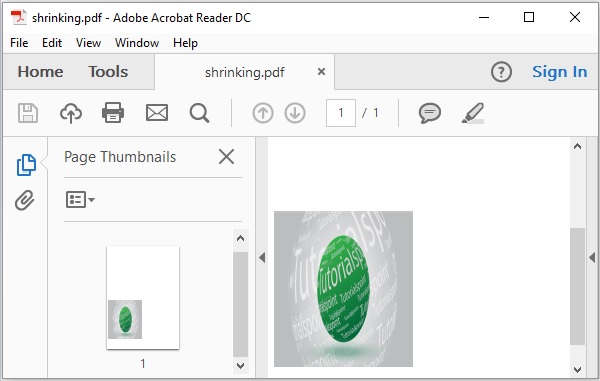
iText - Tiling PDF Pages
The following Java program demonstrates how to tile the contents of a PDF page to different pages using the iText library. It creates a PDF document with the name tilingPdfPages.pdf and saves it in the path C:/itextExamples/.
Save this code in a file with the name TilingPDFPages.java.
import com.itextpdf.kernel.geom.AffineTransform;
import com.itextpdf.kernel.geom.PageSize;
import com.itextpdf.kernel.geom.Rectangle;
import com.itextpdf.kernel.pdf.PdfDocument;
import com.itextpdf.kernel.pdf.PdfPage;
import com.itextpdf.kernel.pdf.PdfReader;
import com.itextpdf.kernel.pdf.PdfWriter;
import com.itextpdf.kernel.pdf.canvas.PdfCanvas;
import com.itextpdf.kernel.pdf.xobject.PdfFormXObject;
public class TilingPDFPages {
public static void main(String args[]) throws Exception {
// Creating a PdfWriter object
String dest = "C:/itextExamples/tilingPdfPages.pdf";
PdfWriter writer = new PdfWriter(dest);
// Creating a PdfReader
String src = "C:/itextExamples/pdfWithImage.pdf";
PdfReader reader = new PdfReader(src);
// Creating a PdfDocument objects
PdfDocument destpdf = new PdfDocument(writer);
PdfDocument srcPdf = new PdfDocument(reader);
// Opening a page from the existing PDF
PdfPage origPage = srcPdf.getPage(1);
// Getting the page size
Rectangle orig = origPage.getPageSizeWithRotation();
// Getting the size of the page
PdfFormXObject pageCopy = origPage.copyAsFormXObject(destpdf);
// Tile size
Rectangle tileSize = PageSize.A4.rotate();
AffineTransform transformationMatrix =
AffineTransform.getScaleInstance(tileSize.getWidth() / orig.getWidth() *
2f, tileSize.getHeight() / orig.getHeight() * 2f);
// The first tile
PdfPage page =
destpdf.addNewPage(PageSize.A4.rotate());
PdfCanvas canvas = new PdfCanvas(page);
canvas.concatMatrix(transformationMatrix);
canvas.addXObject(pageCopy, 0, -orig.getHeight() / 2f);
// The second tile
page = destpdf.addNewPage(PageSize.A4.rotate());
canvas = new PdfCanvas(page);
canvas.concatMatrix(transformationMatrix);
canvas.addXObject(pageCopy, -orig.getWidth() / 2f, -orig.getHeight() / 2f);
// The third tile
page = destpdf.addNewPage(PageSize.A4.rotate());
canvas = new PdfCanvas(page);
canvas.concatMatrix(transformationMatrix);
canvas.addXObject(pageCopy, 0, 0);
// The fourth tile
page = destpdf.addNewPage(PageSize.A4.rotate());
canvas = new PdfCanvas(page);
canvas.concatMatrix(transformationMatrix);
canvas.addXObject(pageCopy, -orig.getWidth() / 2f, 0);
// closing the documents
destpdf.close();
srcPdf.close();
System.out.println("PDF created successfully..");
}
}
Compile and execute the saved Java file from the Command prompt using the following commands −
javac TilingPDFPages.java java TilingPDFPages
Upon execution, the above program creates a PDF document, displaying the following message.
PDF created successfully..
If you verify the specified path, you can find the created PDF document, as shown below −
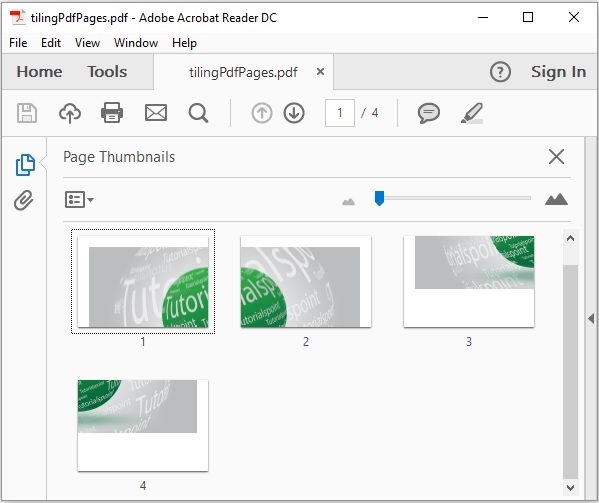
iText - N-up
The following Java program demonstrates how to perform N-up on a PDF page using the iText library. It creates a PDF document with the name nUppingPDF.pdf and saves it in the path C:/itextExamples/
Save this code in a file with the name NUppingPDF.java.
import com.itextpdf.kernel.geom.AffineTransform;
import com.itextpdf.kernel.geom.PageSize;
import com.itextpdf.kernel.geom.Rectangle;
import com.itextpdf.kernel.pdf.PdfDocument;
import com.itextpdf.kernel.pdf.PdfPage;
import com.itextpdf.kernel.pdf.PdfReader;
import com.itextpdf.kernel.pdf.PdfWriter;
import com.itextpdf.kernel.pdf.canvas.PdfCanvas;
import com.itextpdf.kernel.pdf.xobject.PdfFormXObject;
public class NUppingPDF {
public static void main(String args[]) throws Exception {
// Creating a PdfWriter object
String dest = "C:/itextExamples/nUppingPDF.pdf";
PdfWriter writer = new PdfWriter(dest);
// Creating a PdfReader
String src = "C:/itextExamples/pdfWithImage.pdf";
PdfReader reader = new PdfReader(src);
// Creating a PdfDocument objects
PdfDocument destpdf = new PdfDocument(writer);
PdfDocument srcPdf = new PdfDocument(reader);
// Opening a page from the existing PDF
PdfPage origPage = srcPdf.getPage(1);
Rectangle orig = origPage.getPageSize();
PdfFormXObject pageCopy = origPage.copyAsFormXObject(destpdf);
// N-up page
PageSize nUpPageSize = PageSize.A4.rotate();
PdfPage page = destpdf.addNewPage(nUpPageSize);
PdfCanvas canvas = new PdfCanvas(page);
// Scale page
AffineTransform transformationMatrix = AffineTransform.getScaleInstance(
nUpPageSize.getWidth() / orig.getWidth() /
2f, nUpPageSize.getHeight() / orig.getHeight() / 2f);
canvas.concatMatrix(transformationMatrix);
// Add pages to N-up page
canvas.addXObject(pageCopy, 0, orig.getHeight());
canvas.addXObject(pageCopy, orig.getWidth(), orig.getHeight());
canvas.addXObject(pageCopy, 0, 0);
canvas.addXObject(pageCopy, orig.getWidth(), 0);
// closing the documents
destpdf.close();
srcPdf.close();
System.out.println("PDF created successfully..");
}
}
Compile and execute the saved Java file from the Command prompt using the following commands −
javac NUppingPDF.java java NUppingPDF
Upon execution, the above program creates a PDF document displaying the following message.
PDF created successfully..
If you verify the specified path, you can find the created PDF document, as shown below.
